Arkansas is home to many Eastern US and Southern US species. The state is home to both venomous and non-venomous snakes.
Summertime marks the period most of these snakes can be seen in their natural habitat while some fossorial species might seem elusive as they live in loose ground.
Table of Contents
Are There Venomous Snakes in Arkansas?
There are 6 venomous snakes in Arkansas. Northern Cottonmouth, Eastern Copperhead, Timber Rattlesnake, Pygmy Rattlesnakes, Western Diamond-backed Rattlesnake, and Texas Coralsnake species are all highly venomous and native to Arkansas.
While they rarely bite, these snakes are highly venomous and require medical attention in case of a bite.
Even non-venomous snakes in Arkansas can bite. Still, most species prefer to flee when seeing humans.
Aquatic, arboreal, terrestrial, and hybrid snake species are found across the state.
6 Venomous Snakes in Arkansas
The following species are highly venomous and native to Arkansas.
1. Northern Cottonmouth
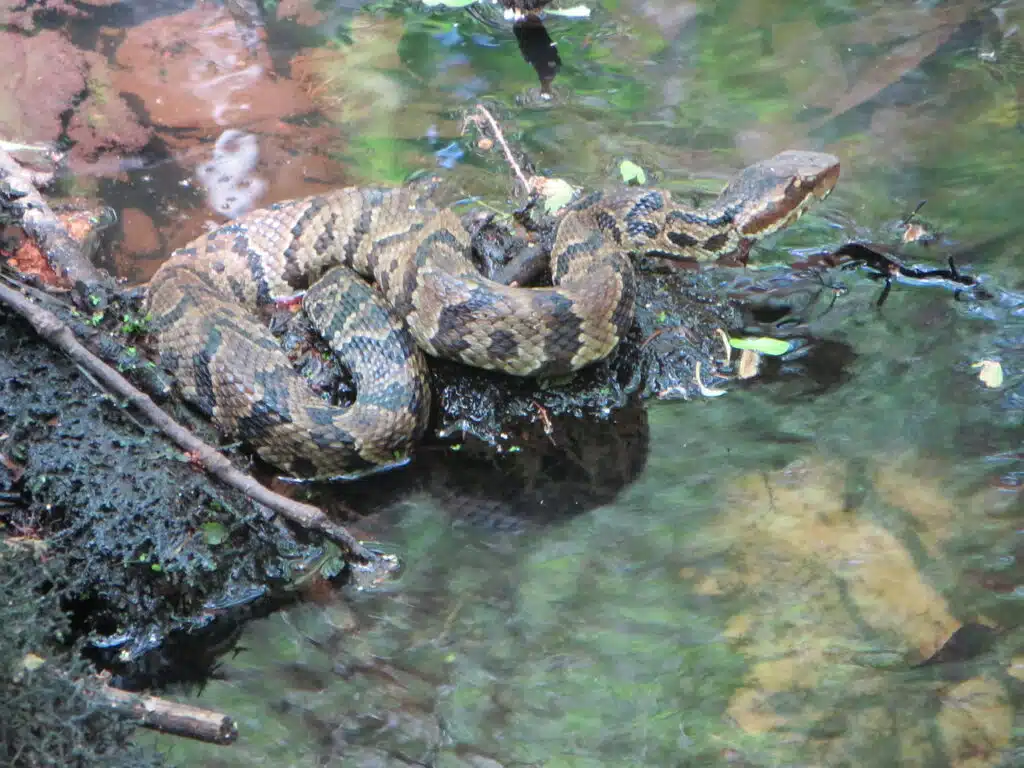
Arkansas is home to one of the most venomous water snakes in the US, the Northern Cottonmouth (Agkistrodon piscivorus).
This is a species that shows adaptation to feeding, especially on fish. It can rotate its head around the swallowed prey for higher efficiency.
Also known as a Water Moccasin, the Northern Cottonmouth has one of the most venomous bites to humans.
This brown, gray, and black snake live in swamps, ponds, and other habitats close to water.
It has also shown some adaptation to live on dryer land no further than 2 miles from a water source.
The bites of this species are rare in Arkansas compared to areas in The Gulf of Mexico but they still pose a tissue-destroying risk through cytotoxic venom.
2. Eastern Copperhead
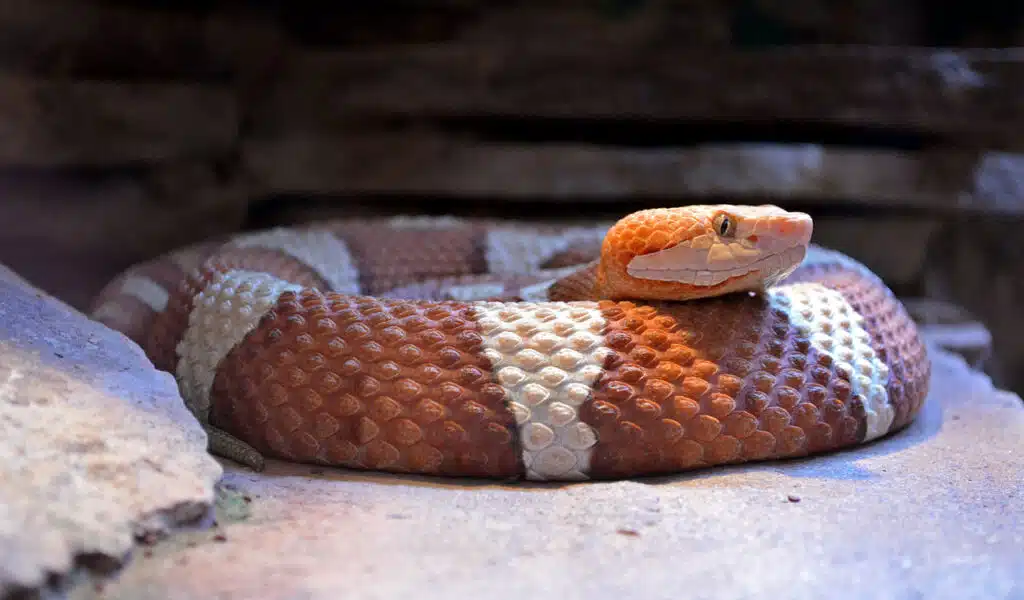
Eastern Copperheads (Agkistrodon contortrix) represent a heavy species of venomous snakes found in Arkansas.
This snake has multiple shades of brown with dark brown hourglass marks across its body.
Woodlands and areas next to woodlands are some of its common habitats.
This snake is a generalist feeder that likes to ambush its prey. It doesn’t move much as a result.
The bites of the species can be deadly, but only in extreme cases.
Some of the early signs of its venom bites include nausea and pain. The bitten area can show permanent tissue damage.
Antivenom might be given to those bitten by the Eastern Copperhead snake, but with possible reactions for those with allergies.
3. Timber Rattlesnake
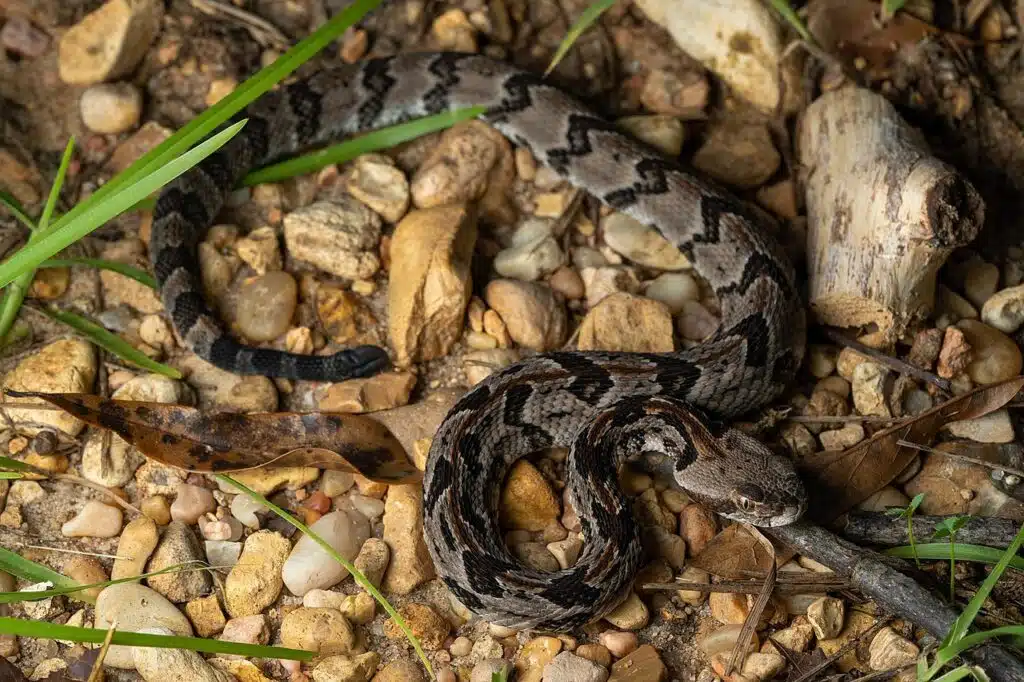
Timber Rattlesnakes (Crotalus horridus) are some of the most venomous species in Arkansas. This is a snake that shows aggressive behavior towards humans when roughly handled and even towards other snakes.
Timber Rattlesnakes can eat juvenile Rattlesnakes and Garter Snakes.
Most people know the species might their venomous bite which requires medical attention and even an antivenin.
One of the first signs of a Timber Rattlesnake bite includes seeing black swollen skin in the area of the bite.
The color of the skin may return to normal but the skin itself might not recover to its normal texture.
4. Pygmy Rattlesnake
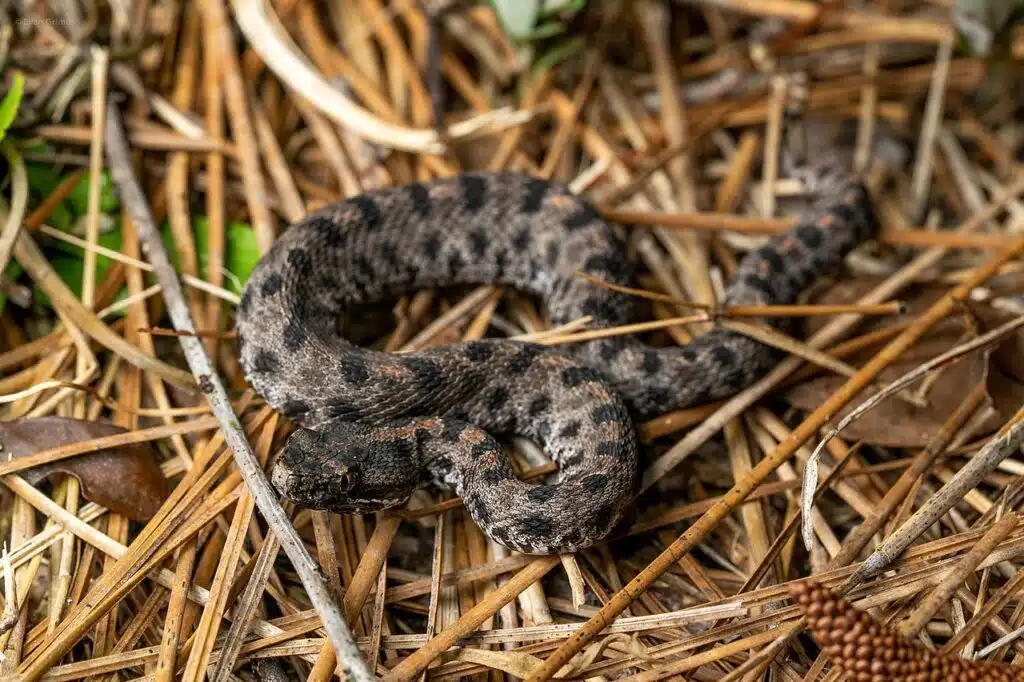
Woods and dunes are among the common habitats of the Pygmy Rattlesnake (Sistrurus miliarius).
This is one of the most venomous snakes in The United States. It can still be spotted around marshes and permanent sources of water.
A rattle at the tip of its tail, and a gray and black body are used for species identification.
This species is mostly interested in feeding frogs, birds, and mammals.
Its bite is venomous and highly painful.
Requiring medical attention and even hospitalization, Pygmy Rattlesnakes have cytotoxic venom.
The venom of this rattlesnake is known to cause hemorrhagic reactions.
This snake is an ambush predator, similar to other venomous species.
5. Western Diamond-backed Rattlesnake
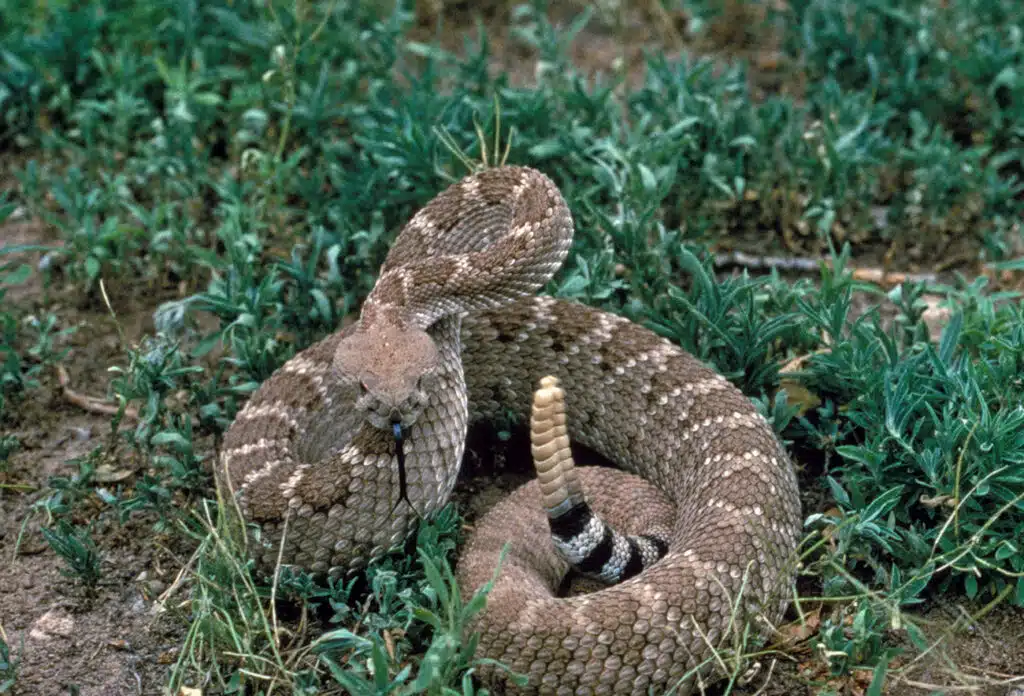
Western and central regions of Arkansas are the home habitat of the Western Diamond-backed Rattlesnake (Crotalus atrox).
This snake is sometimes even found in homes, as opposed to other venomous species found less in homes.
Reduced populations of Western Diamond-backed Rattlesnakes are caused by human activity and by people killing this dangerous snake.
However, Western Diamond-backed Rattlesnake is adaptive. This species can survive up to 2 years without food.
Some of the early signs of a Western Diamond-backed Rattlesnake bite include numbness, general muscle weakness, and breathing difficulties.
Later signs of its bite include vomiting and blurred vision.
The venom of the species might also cause excessive bleeding known as hemorrhagia.
6. Texas Coralsnake
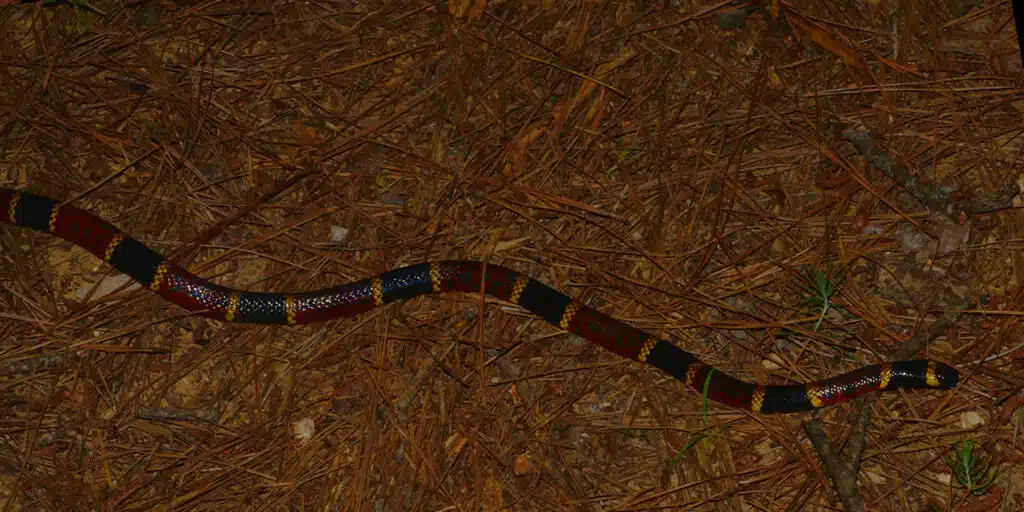
A few hundred snakes of the Texas Coralsnake (Micrurus tener) genus are still found in Arkansas.
This is one of the few slender venomous snakes in the state with dark red or brown coloring.
Texas Coralsnakes have neurotoxic venom with delayed symptoms.
While rare, its bites lead to symptoms that appear after a few hours.
Even those that seem fine eventually see one of the symptoms such as headache, breathing difficulties, and partial paralysis.
Most bites happen when the snake is surprised or stepped on.
Texas Coralsnakes hide under leaf litter on the ground. They only come out at night as a purely nocturnal predator.
The diet of this species is also slightly atypical compared to the diet of other venomous snakes in Arkansas.
Texas Coralsnakes mainly eat other snakes. They prefer juveniles of other species but routinely eat their juveniles in common acts of cannibalism.
36 Non-venomous Snakes in Arkansas
There are considerably more non-venomous snakes in Arkansas compared to venomous species.
1. Western Ratsnake
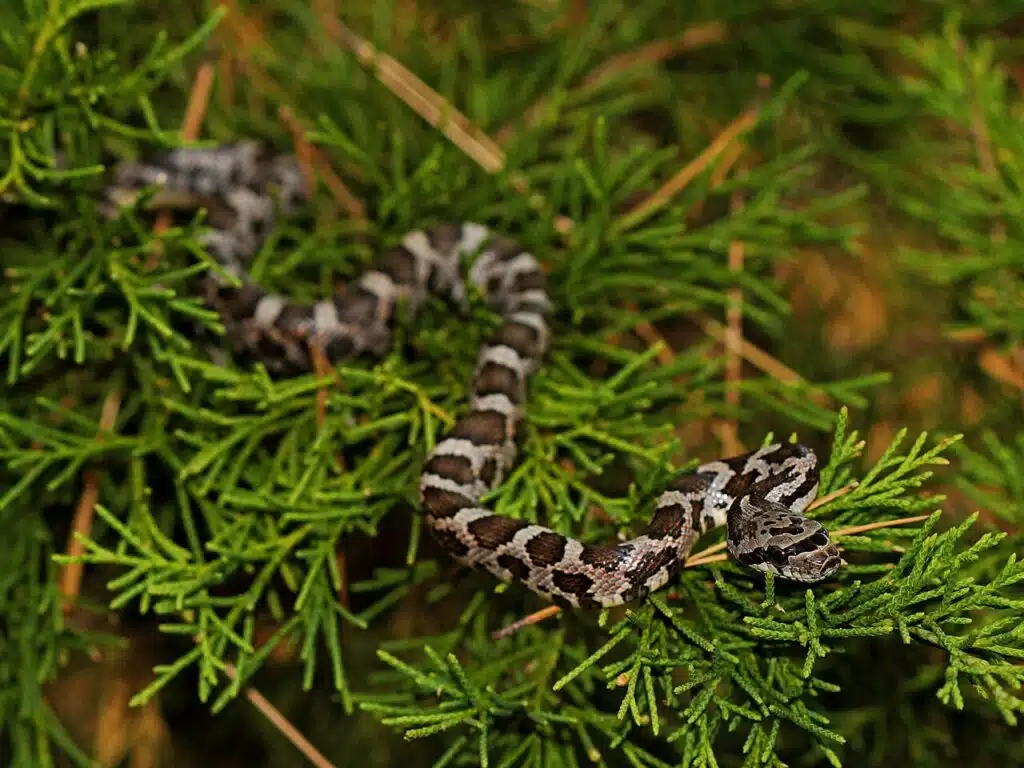
Black is the dominant color of the Western Ratsnake (Pantherophis obsoletus). This is a species known for its habitat adaptability.
It primarily lives around oak woodlands but it can also be seen on rocky terrains and in types of dry habitats.
Western Ratsnakes are a non-venomous species that are active in the summer. The diurnal snake is often seen in direct sunlight in the summer.
The species is rarely seen in the winter when it prefers to hide in dens.
One of the species it shares its overwintering locations is the Timber Rattlesnake.
Its den-sharing habit has led to the assumption that the Western Ratsnake is venomous.
Western Ratsnakes are some of the most agile species in Arkansas.
The snake can climb trees but it can also swim, which opens up its diet based on constriction techniques.
2. Ring-necked Snake
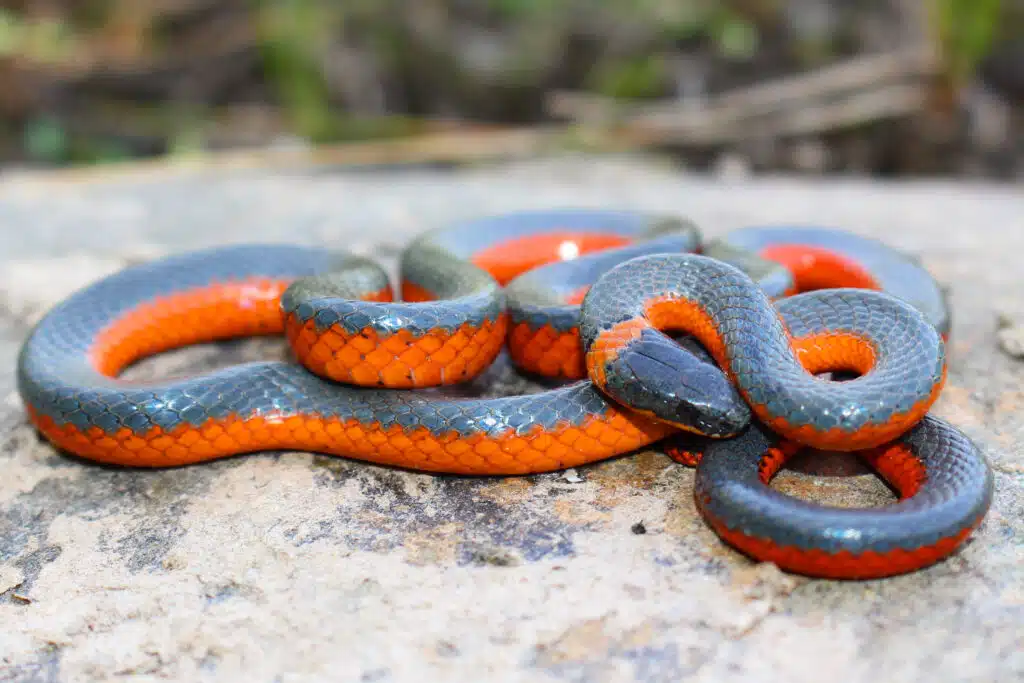
Some of the smallest snakes in Arkansas are Ring-necked Snakes (Diadophis punctatus). This is a species with a dark gray color with a bright cream to a white ring around its head.
A nocturnal species, Ring-necked Snakes are primarily found in woodlands. It needs plenty of leaves to hide around and good spots in the ground to use as dens.
The species prefer to eat salamanders, a common sight in woodlands.
Earthworms are also frequently consumed by the species. Its diet is opportunistic as this species eats salamanders and earthworms whenever it finds them.
While a small species, Ring-necked Snakes are constrictors or partial constrictors as they also use venomous saliva to overpower prey.
The bite of the snake is not harmful to humans. Furthermore, these snakes rarely bite even when handled.
3. Speckled Kingsnake
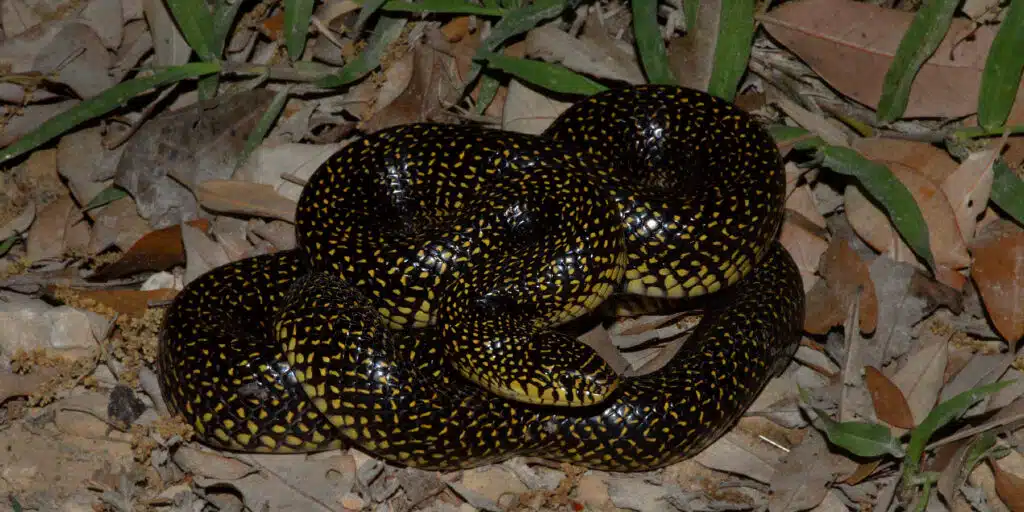
A typical non-venomous snake in the state is the Speckled Kingsnake (Lampropeltis holbrooki).
This is a species with a mostly black-speckled body that is seen across various habitats.
As an omnivore, the Speckled Kingsnake is mostly seen looking for food such as small mammals.
It eats rodents, birds, and lizards, among other species.
This snake species is mostly seen around water sources and on dry land occasionally.
Swamps tend to attract the highest numbers of Speckled Kingsnakes.
4. Dekay’s Brownsnake
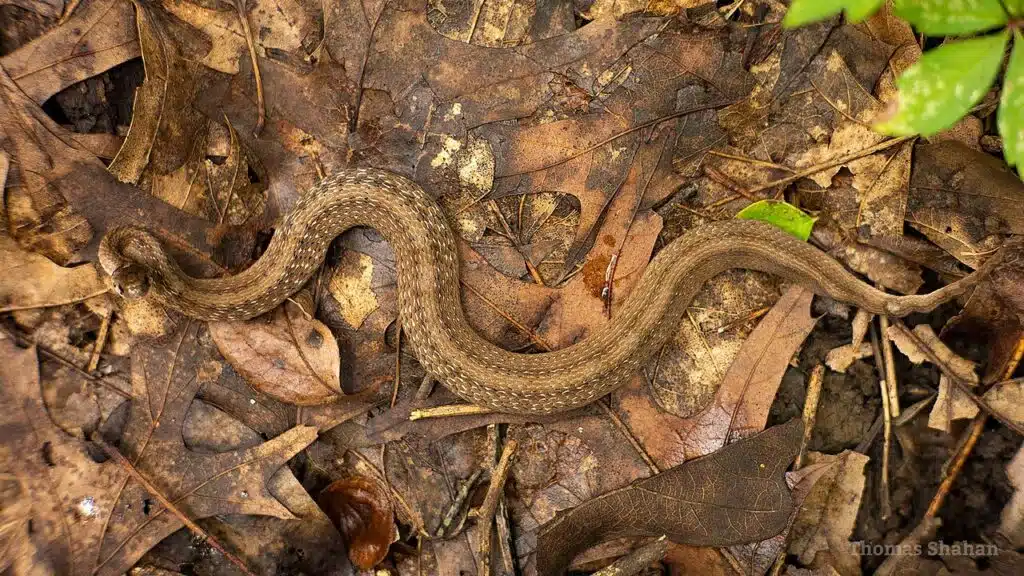
Dekay’s Brownsnakes (Storeria dekayi) are among the typical aquatic species in the state. This small snake has a brown color with light and dark nuances.
The species bears a coloring resemblance to other brown snakes.
Slugs and snails are among the most common foods of this species which is often confused with venomous snakes.
Dekay’s Brownsakes can also show different diet habits according to their regions in the state.
Frogs and toads are the less common prey of the species.
The snake is among the species with a reduced size. It may grow to a length of 15 inches, making it one of the smaller snakes with a thick robust body in Arkansas.
It can be distinguished from similarly-sized snakes by its very keeled appearance.
These snakes can be spotted in early spring, a time when they come out of hibernation.
5. Common Garter Snake
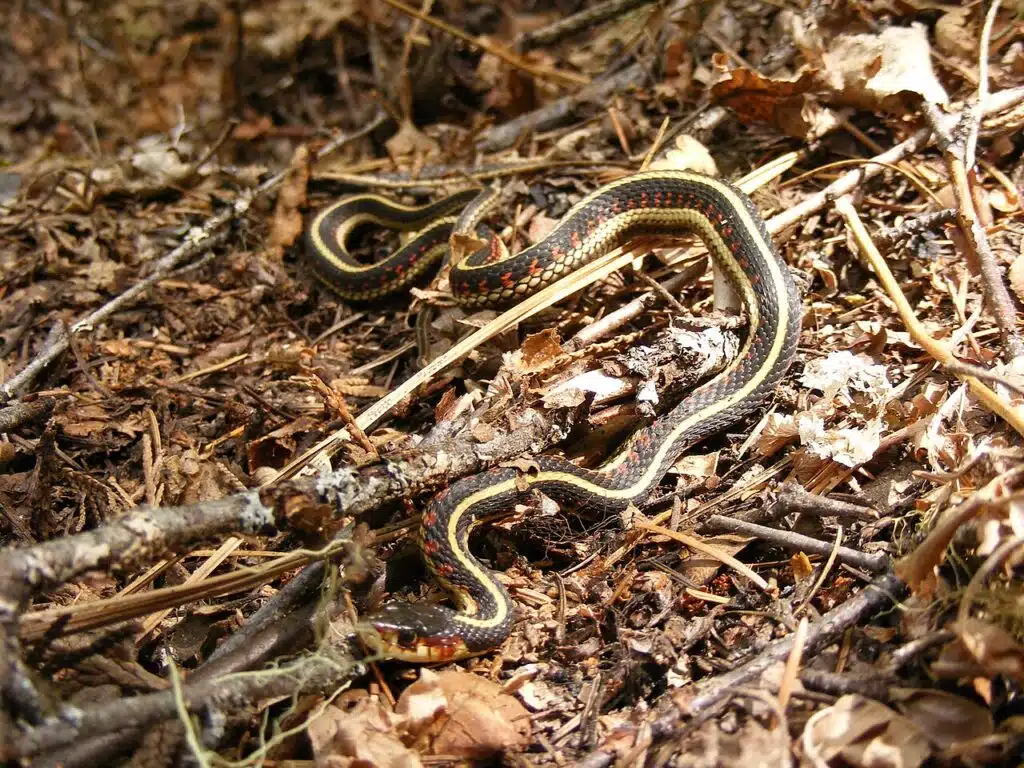
Grasslands and forests are among the normal habitats for the Common Garter Snake (Thamnophis sirtalis).
This is one of the species which ends up killed by cars on roads, a common factor for its lowering numbers in some areas.
Common Garter Snakes have an important role in their habitat. They eat small mammals but they are also food for other large predators such as raccoons.
Identified by its striped body, The Common Garter snake is a species that uses venomous saliva against predators such as frogs and toads.
This saliva isn’t dangerous to humans.
Snakes of this family can also eat certain species considered poisonous, such as newts and toads.
Common Garter snakes are a large species that may reach a length of up to 4 feet.
6. Common Watersnake
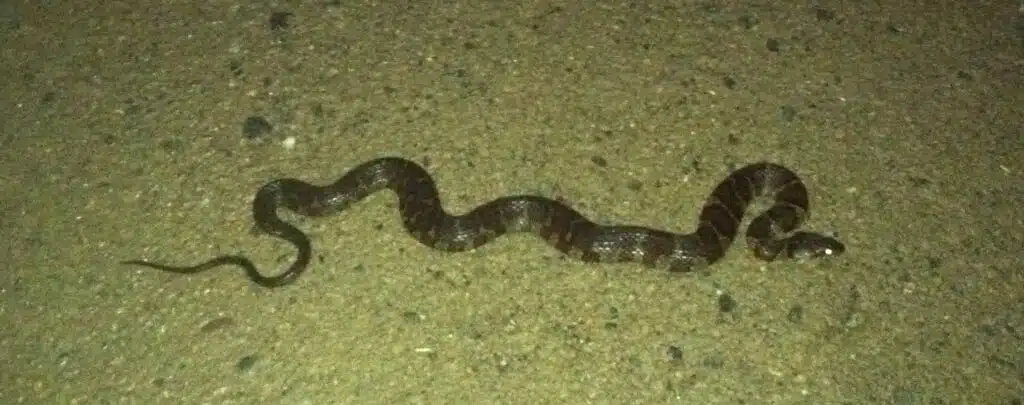
Common Watersnakes (Nerodia sipedon) are another species of large snakes in the state.
The snake has dark coloring and may appear black when seen from above.
You can find Common Watersnakes next to ponds, streams, rivers, and around marshes.
The size of the water source dictates the type of Common Watersnakees you can find.
Small juveniles like smaller streams and ponds as they tend to come with a reduced number of potential predators.
This species is also highly aggressive and doesn’t like to be cornered or handled.
While non-venomous, The Common Watersnake bites multiple times when threatened.
While you can encounter the snakes next to water, basking on rocks, it’s best to avoid the species as it bites without warning signs.
7. Plain-bellied Watersnake
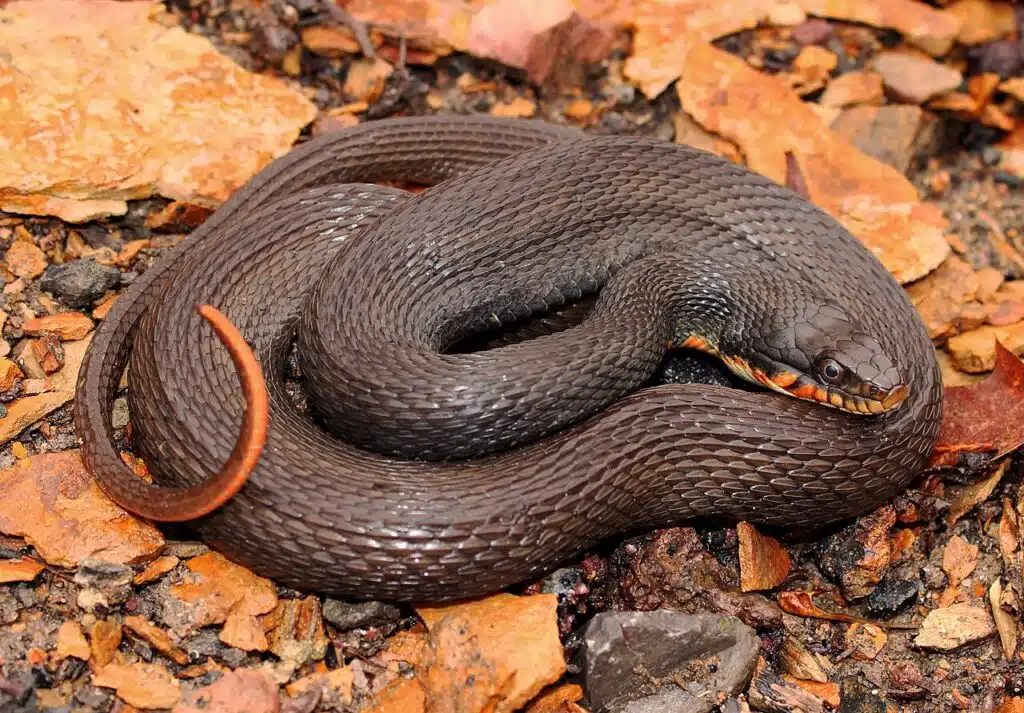
Plain-bellied Watersnakes (Nerodia erythrogaster) may share their habitat with species such as The Common Watersnakes as both are aquatic or semi-aquatic.
Plain-bellied Watersnakes are named after their cream or yellow ventral color.
This is a species that shows more preference for an aquatic environment compared to The Common Watersnake.
It feeds on crayfish and fish to a large extent.
Frogs are lower on the list of prey preferences for this species which can be adaptive and even eat dead animals when going hungry.
The period of early summer is the time when this species mates and when it’s most likely to be spotted out of the water.
Female Plain-bellied Watersnakes give birth to live young towards the end of the summer.
8. North American Racer
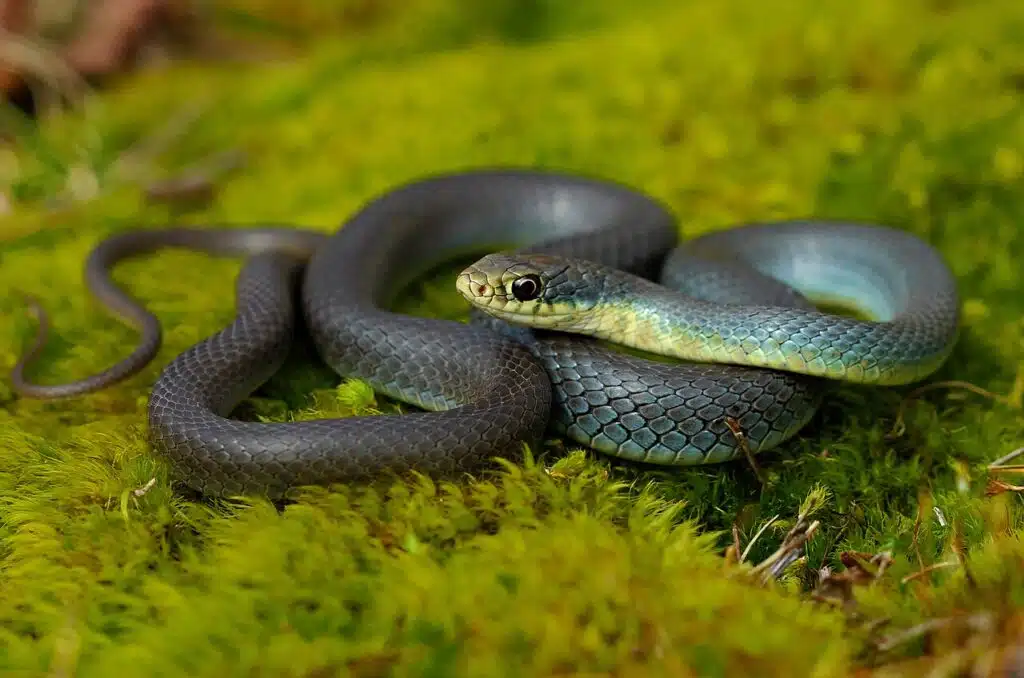
North American Racers (Coluber constrictor) are among the highly active species in the state.
This snake moves for food during the day and it might even climb looking for bird nests and bird eggs.
North American Racers also eat rodents and other small mammals.
Juveniles North American Racers are a few times smaller than adults and have different food preferences.
A juvenile snake can measure up to 10 inches and insects make up the bulk of its diet.
Both adults and juveniles can be found in open grassland habitats in the state.
The species isn’t docile and it has different self-defense techniques such as releasing a foul smell and even biting multiple times.
9. Rough Greensnake
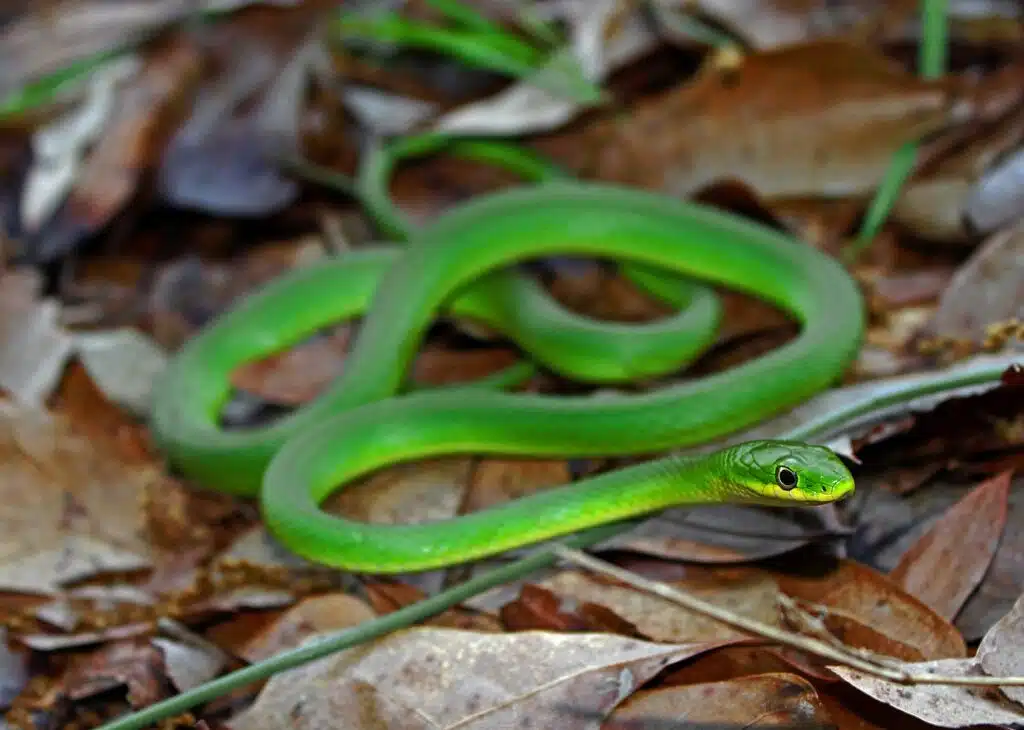
Some of the smallest snakes in Arkansas that can climb and swim are Rough Greensnakes (Opheodrys aestivus).
A slender species, this snake is characterized by bright green dorsal coloring and yellow or pale ventral coloring.
It can be found on dense water vegetation, on the ground, and up on trees during the day, unlike most other snakes in the state.
Rough Greensnakes are a species that feeds on arthropods and can be spotted covering long distances for food.
The species requires a very specific habitat as it often seeks refuge against predators such as birds in vegetation.
The snake doesn’t have any defense techniques like other species in Arkansas and it also faces a diminishing habitat through industrialization.
10. Banded Watersnake
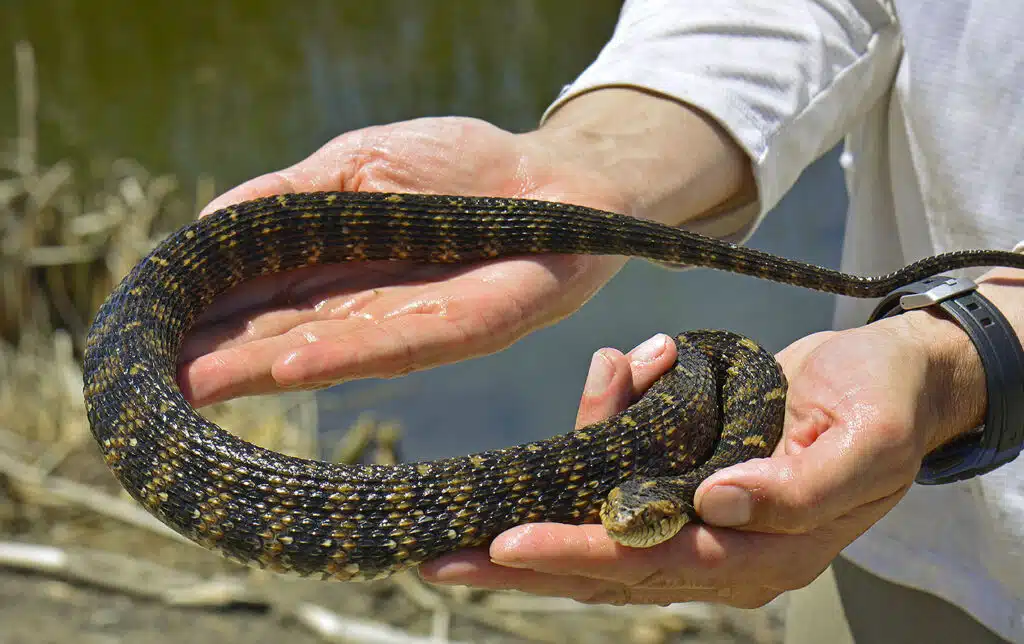
As an aquatic species, Banded Watersnakes (Nerodia fasciata) are a species found around ponds, lakes, streams, and marshes.
This is a common species across the state that gives birth to clusters of up to 20 young juveniles next to water.
A non-venomous species, Banded Watersnakes are dark gray, brown, or black, with contrasting dark crossbands.
People may encounter these types of snakes next to water, especially water surrounded by vegetation.
It climbs to vegetation just above the water so that it has access to different types of prey.
Frogs are among the prey commonly found in their humid habitats.
11. Western Ribbon Snake

A small black species with yellow and red stripes, the Western Ribbon Snake (Thamnophis proximus) is a species that lives close to water.
While mostly spending its day out of the water, this small species can swim and it uses water as a means of escape.
This small snake uses vegetation in humid areas such as land around water to find frogs, which make up the bulk of its diet.
These snakes are specialized in preying on frogs and they can mimic strikes to make frogs move out of their hiding spots.
Western Ribbon Snakes quickly reach sexual maturity before they reach the age of 1, ready to reproduce.
The Western Ribbon Snake is a species with a short lifespan. Many individuals don’t survive for more than 3 years.
12. Diamondback Watersnake
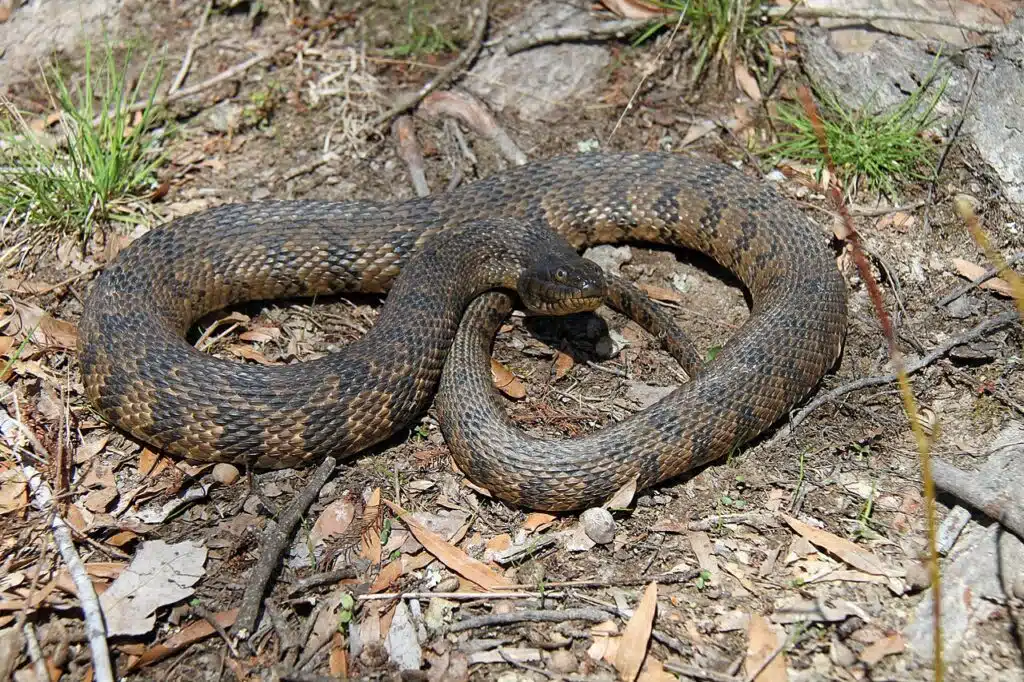
Diamondback Watersnakes (Nerodia rhombifer) have a dark color body with heavily-keeled scales.
It shares its habitat with other species such as Western Ribbon Snakes as both species are found close to water.
The coloring of the species varies according to its location.
Many Diamondback Watersnakes have a dark green color with black crossbands.
An olive-green morph of the species is also common.
Yellow ventral coloring is also specific to this snake.
The end of the summer marks the period when female Diamond Watersnakes may be encountered as they give birth to live young.
Newborn juveniles of the species measure anywhere between 8 and 10 inches.
13. Western Worm Snake
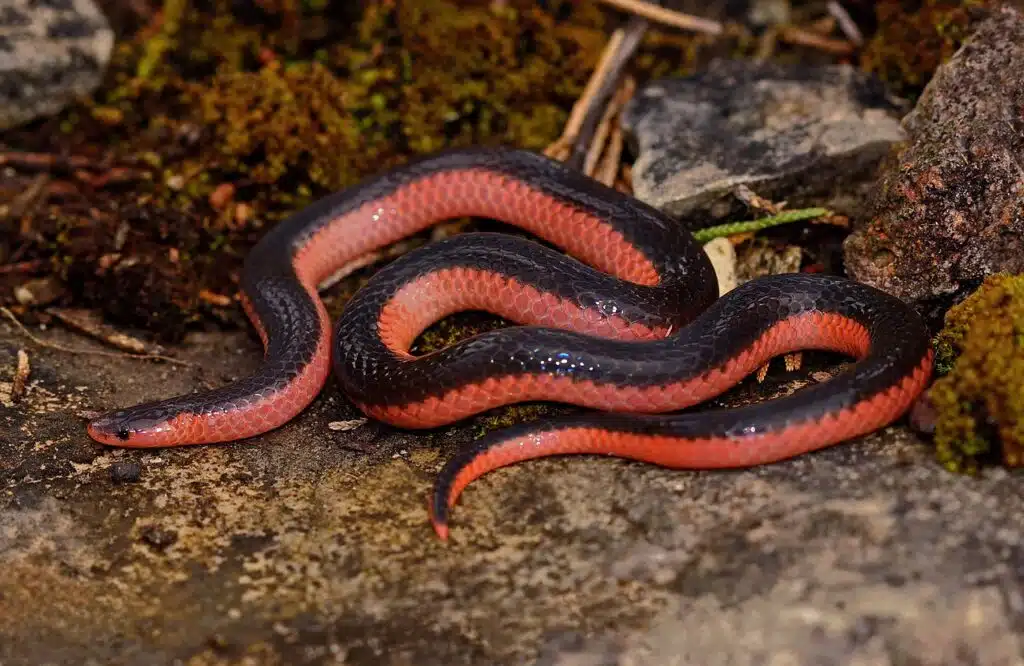
Northwestern Arkansas territories are home to the Western Worm Snake (Carphophis vermis).
Black dorsal coloring and pink to red ventral coloring are specific to the species.
Most of its life is spent hiding in the ground or under leaves. This species is highly secretive and it also mates in secret away from predators.
The Western Worm Snake has a small size which only allows it to consume prey such as earthworms.
A non-venomous species, the Western Worm Snake is also a species that can defend itself by releasing a foul smell.
This species may also attempt to push predators away with the tip of its tail.
The snake rarely bites humans as it prefers to flee and hide in the foliage.
14. Red-bellied Snake
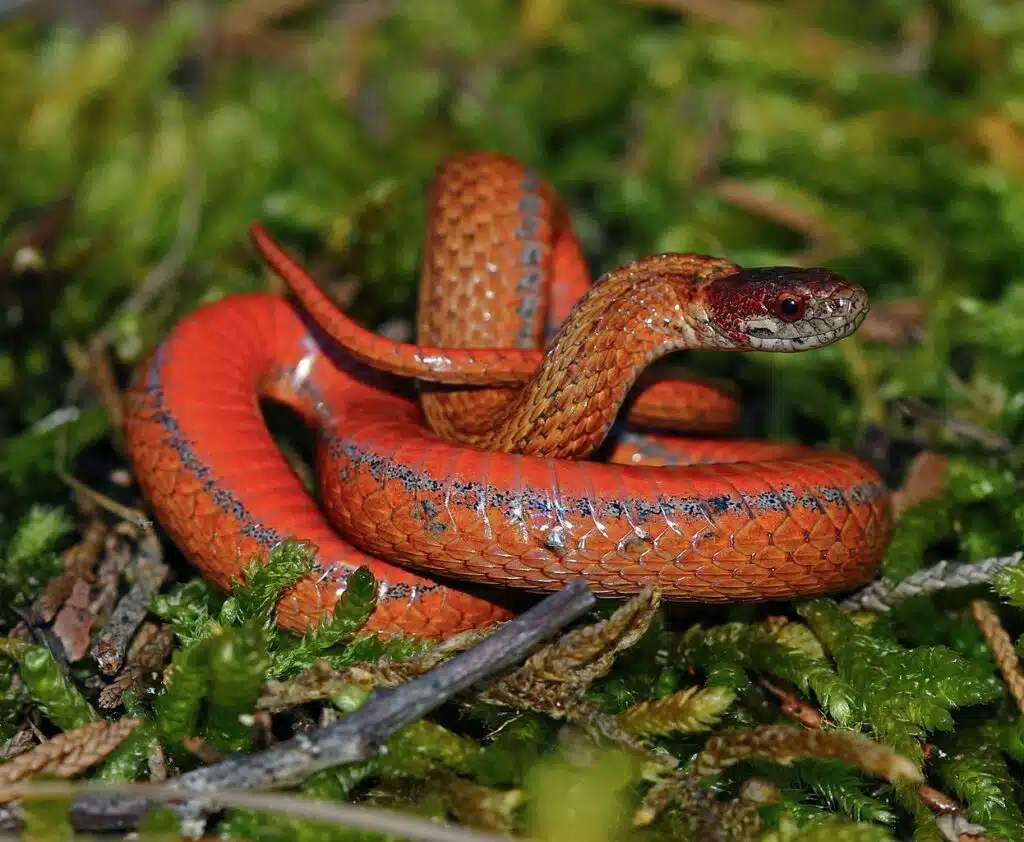
A similar species is the small Red-bellied Snake (Storeria occipitomaculata).
This secretive snake specie only grows to a size of a few inches.
While it can reach a maximum size of 10 inches, the snake is typically shorter, measuring anywhere between 6 and 8 inches.
Its name is derived from its vivid red ventral coloring.
Red-bellied Snakes are among the species with dark brown or dark gray dorsal coloring.
This color tends to be lighter and closer to bright brown in juveniles.
A different head color is also specific to the Red-bellied Snakes.
A species that are normally associated with coastal plains, the Red-bellied Snake is only found close to bodies of water in Arkansas.
15. Prairie Kingsnake
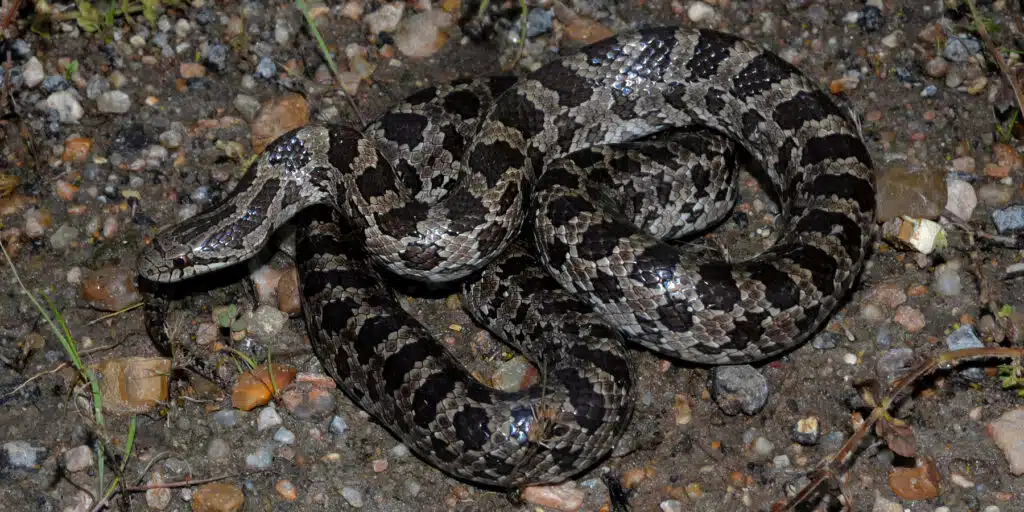
Open fields, prairies, and grasslands are among the habitats of the Prairie Kingsnakes (Lampropeltis calligaster).
This is a species also present around cultivated fields but it tends to have a secretive nature.
Rodents are one of the main reasons the species is present around cultivated fields and farms.
This is also a species that can eat frogs and lizards in the absence of mice and rats.
Prairie Kingsnakes are also known to eat the juvenile snakes of other species.
A brown snake with dark brown blotches, this species might also come in an almost uniform color.
Its size also places it among the larger species in Arkansas. Some of the largest Prairie Kingsnakes can measure up to 40 inches.
16. Eastern Hognose Snake
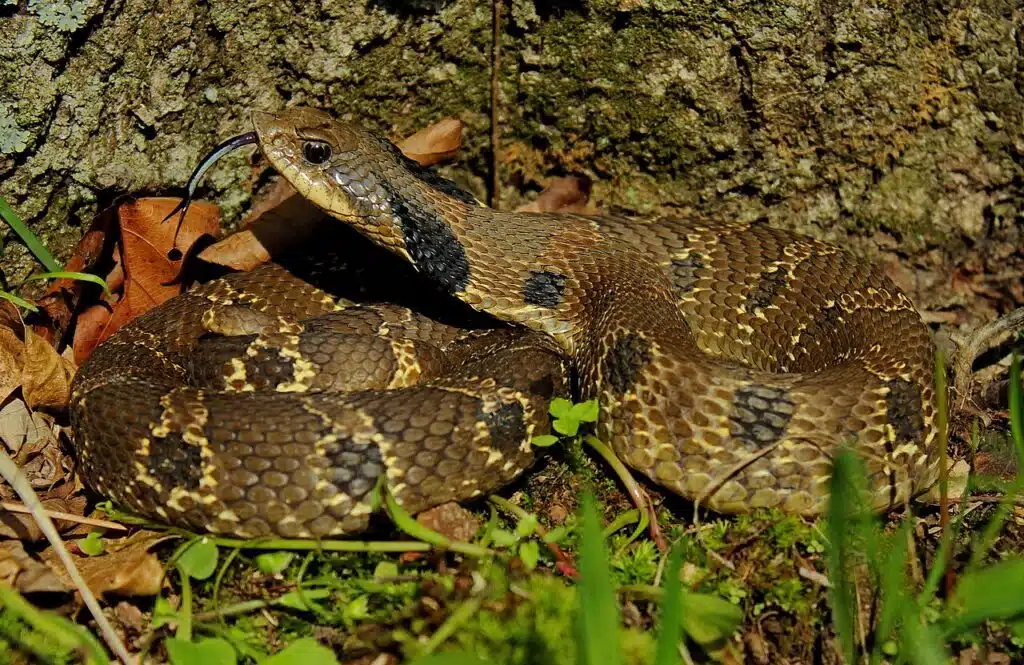
Eastern Hognose Snakes (Heterodon platirhinos) are a common sight across the state, even if under different names such as The Black Adder.
This is a species seen in many colors such as black, brown, and green.
Locals may associate The Eastern Hognose Snake with a venomous species. This is a snake that raises its head and flattens it, similar to a cobra when threatened.
Eastern Hognose Snakes are some of the most important predators of frogs and salamanders.
The species secrete a high amount of countering hormones to deal with the poisonous skin of these species.
Eastern Hognose Snake eggs may be found in secluded areas of vegetation towards mid-summer. These eggs hatch within 2 months.
17. Rough Earthsnake
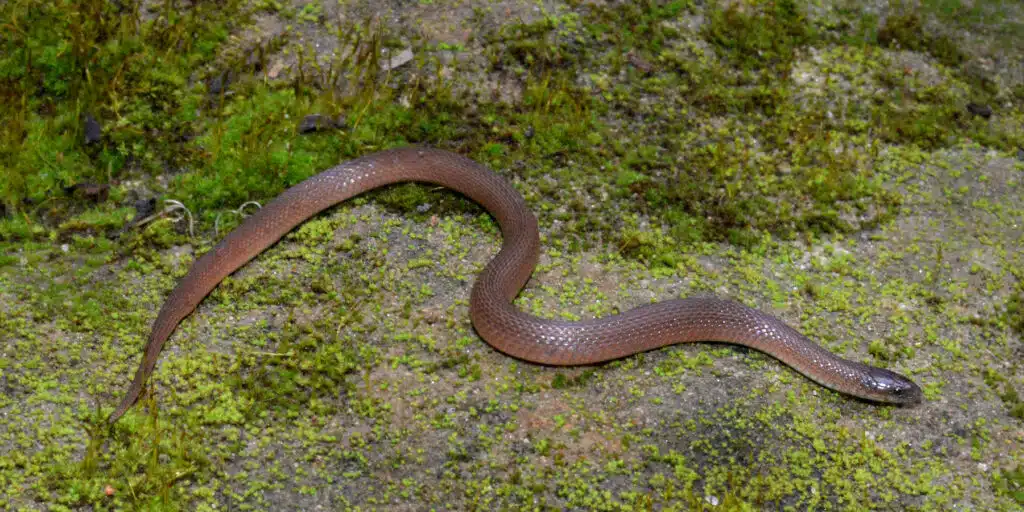
Rough Earthsnakes (Haldea striatula) are part of a large group of fossorial species in Arkansas.
This is a snake that measures an average of 6-7 inches and can be identified by its dark gray color.
Rough Earthquakes are active in the summer. Females give birth to live young.
A typical group of live young counts around 5 individual snakes.
The species is knoRough Earthsnakewn to hide or try to escape when seeing humans.
It doesn’t bite when handled and it generally prefers to avoid biting.
It uses a foul smell of musk to keep predators away in case of close contact.
Sometimes found in gardens, this species can be handled as it has a docile nature towards humans.
18. Smooth Earthsnake
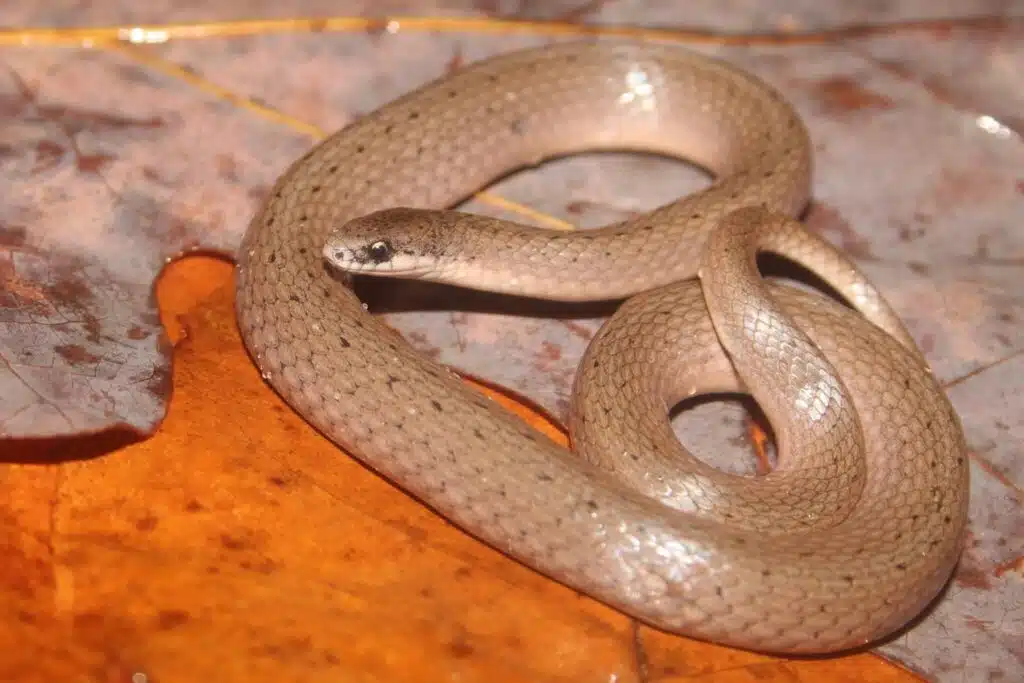
A dark gray or brown-gray color is specific to Smooth Earthsnakes (Virginia valeriae), a species native to Arkansas and Eastern US territories.
The head of Smooth Earthsnakes has a darker color than the rest of the body.
Growing up to a size of 8.8 inches, Smooth Earthsnakes have teeth they use against small prey but which they don’t use against humans as they don’t bite.
Feeding on spiders, caterpillars, and other bugs, this snake is also fossorial, similar to Rough Earthsnakes.
This also means the species live secretive lives underground.
Juveniles of the species are often confused with worms as they only measure 2 to 3 inches when born.
19. Coachwhip
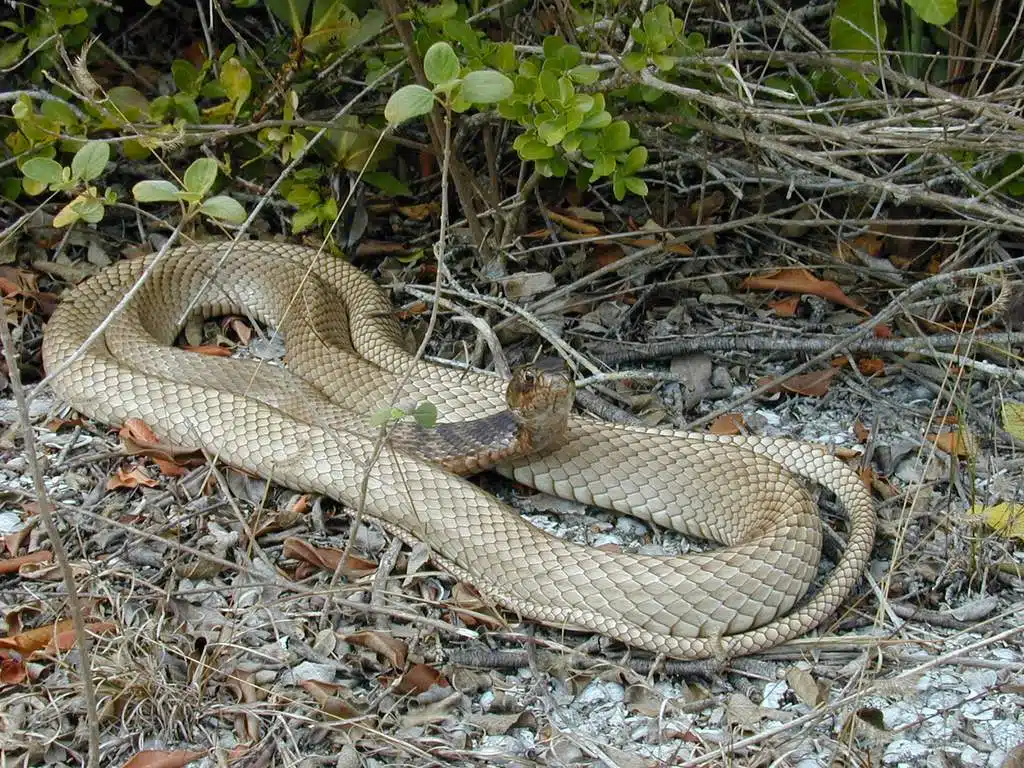
Green, brown, and black nuances are specific to Coachwhip snakes (Masticophis flagellum).
This is a species often spotted with a dark head and an area of the body close to the head.
Coachwhips are some of the largest snakes in Arkansas as some individuals may survive and grow to a size of 90 inches.
Sandy terrains, fields, crops, and prairies are among the habitats preferred by Coachwhips.
The snake can bite if facing humans. Its bite isn’t venomous but it’s described as highly painful.
Snakes of this family also use head movements to tear prey faster when biting.
Mating periods are the only time this species is seen in groups. Mid-summer to the end of August marks their mating period.
Males imitate mating by flicking their tongues to assert dominance.
Juveniles mature sexually soon and they also live solitary lives soon. Coachwhip snakes live up to 3 years.
20. Western Milksnake
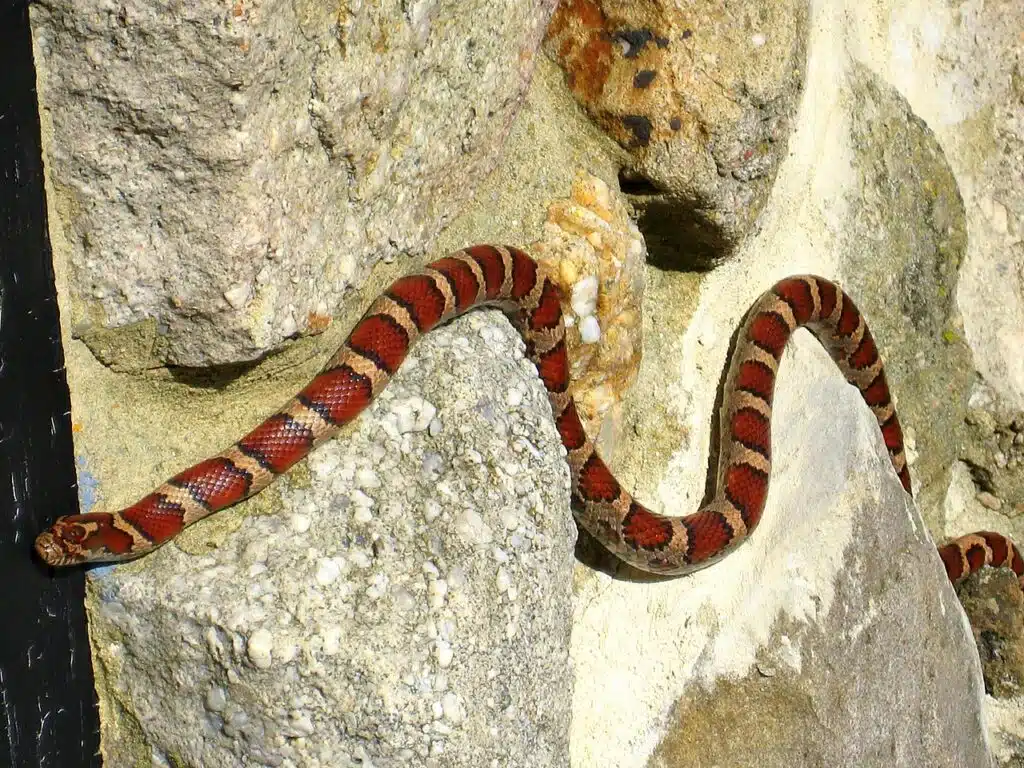
Western Milksnakes (Lampropeltis gentilis) are some of the most colorful species around fields, woodlands, and crops.
The snake comes in red with white and black coloring and other brown-red nuances with either white or yellow crossbands.
Insects and slugs are part of their diet.
These snakes live secretive lives preferring to flee when spotting humans. Milksnakes are also docile when handled.
While bites of the snake can happen, they are rare as the snake typically gives off warning signs first.
Tail rattling is one of the first signs that snakes may bite.
Milksnakes only have small teeth which aren’t dangerous to people.
These snakes are part of local folklore and myths, one of them being they consume milk straight from cows.
21. Mudsnake
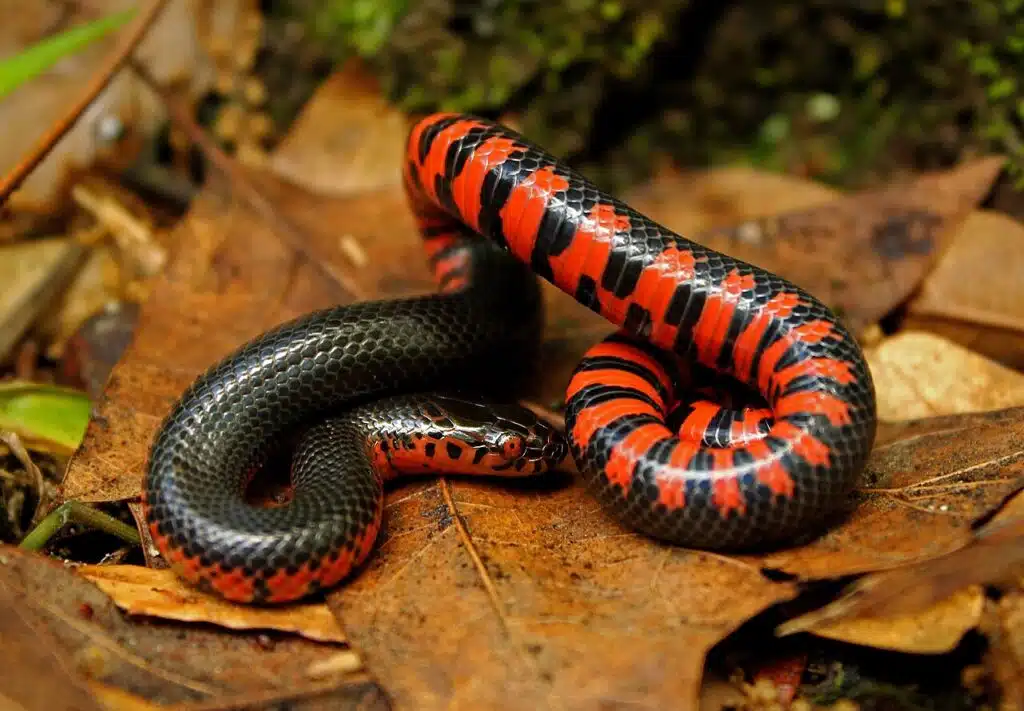
Mudsnakes (Farancia abacura) are one of the black snakes of Arkansas. They have distinct red ventral coloring.
Rarely encountered, Mudsnakes are a species that spends most days in water such as ponds.
The species may be spotted on dry land, mainly to mate or to lay eggs.
Overwintering also takes place on dry land for Mudsnakes.
This species may be perceived as venomous due to its aquatic habitat and its robust body.
However, Mudsnakes are non-venomous.
They use the tip of the tail to check potential predators.
While bites are rare, they can be highly painful. Mudnsakes have large upper teeth they mainly use against slippery salamanders.
22. Flat-headed Snake
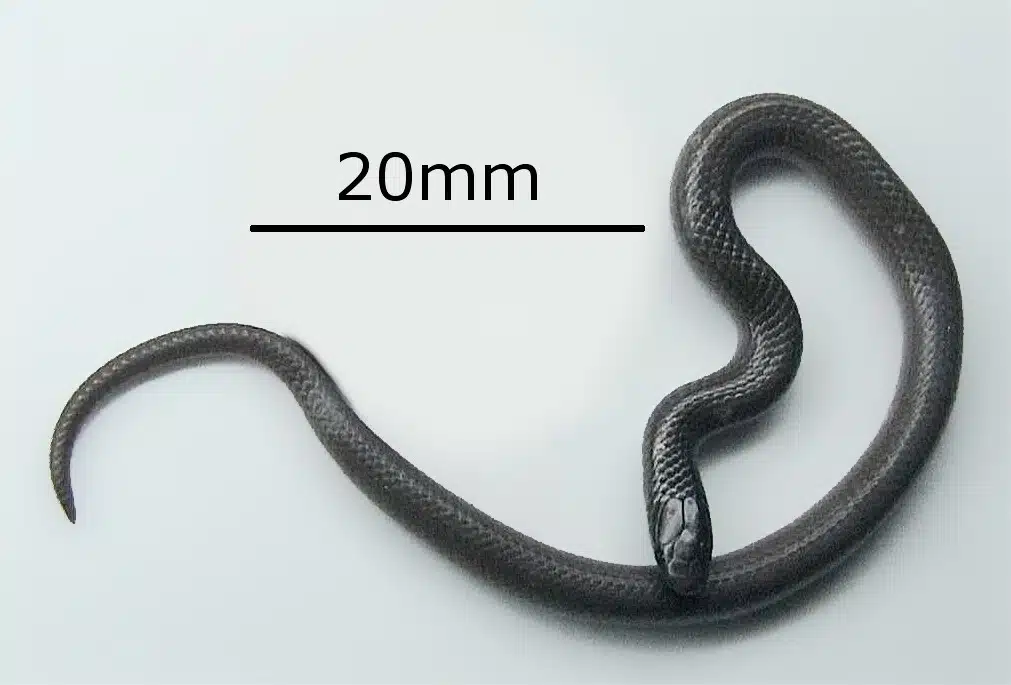
One of the rare species of Arkansas is the Flat-headed Snake (Tantilla gracilis).
This species comes in black with red ventral coloring and brown coloring in its juvenile days.
Flat-headed Snakes are also known to lay a very small number of eggs.
Female Flat-headed Snakes only lay 1 to 4 eggs per mating season.
Flat-headed Snakes are some of the smallest snakes in Arkansas. They barely measure more than 8 inches.
Some snakes of this family may be found in gardens, particularly around rocks which they use for warmth in the sun.
23. Great Plains Ratsnake
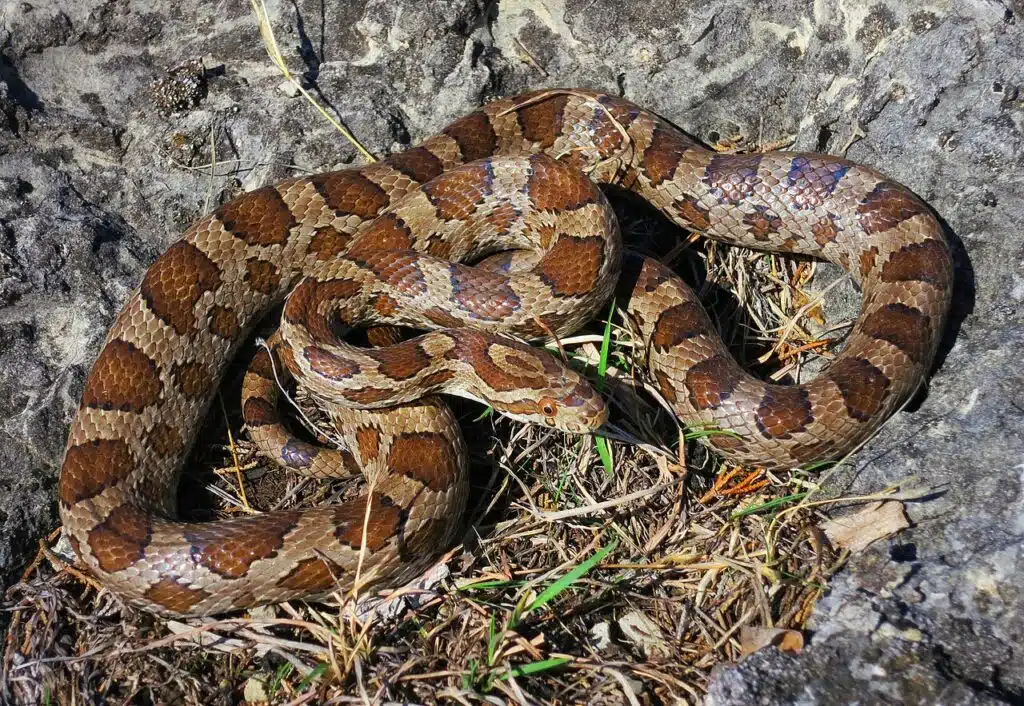
Also known as The Eastern Spotted Snake, Great Plains Ratsnakes (Pantherophis emoryi) are known for their large brown blotches.
This species prefers moderate altitude terrains and mountainous terrains.
It has also adapted to arid climates as it has a diverse diet that also includes juvenile snakes of other species.
Rodents and small birds are the primary food preference of the Great Plains Ratsnakes.
A large species that may reach lengths of up to 5 feet, Great Plains Ratsnakes also lay a large number of eggs after mating.
Female snakes lay more than 20 eggs at a time.
While not an aggressive species, this snake might still bite. Its bites are less painful than the bites of other snakes.
This species also shakes its tail before biting.
24. Graham’s Crayfish Snake
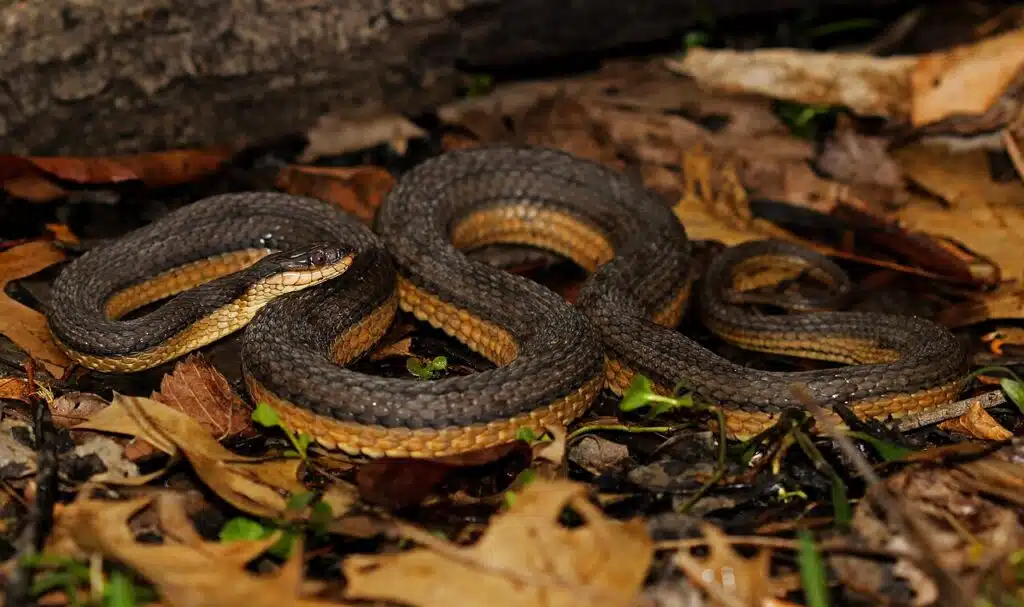
Snakes of this family are rarely seen by humans as they only come out at night so that they aren’t easily spotted by predators.
Graham’s Crayfish Snakes (Regina grahamii) are a species that grows to 28 inches. Gray-to-brown coloring is specific to this species.
Graham’s Crayfish Snakes are aquatic and they spend most nights looking for fresh crayfish.
To a lesser extent, the snake may also eat small fish.
The exclusive diet of the species makes it one of the snakes that cannot be bred in captivity as it doesn’t eat in an enclosed space.
Snakes of this species are known to release a musk-like foul smell when handled.
35. Eastern Milksnake
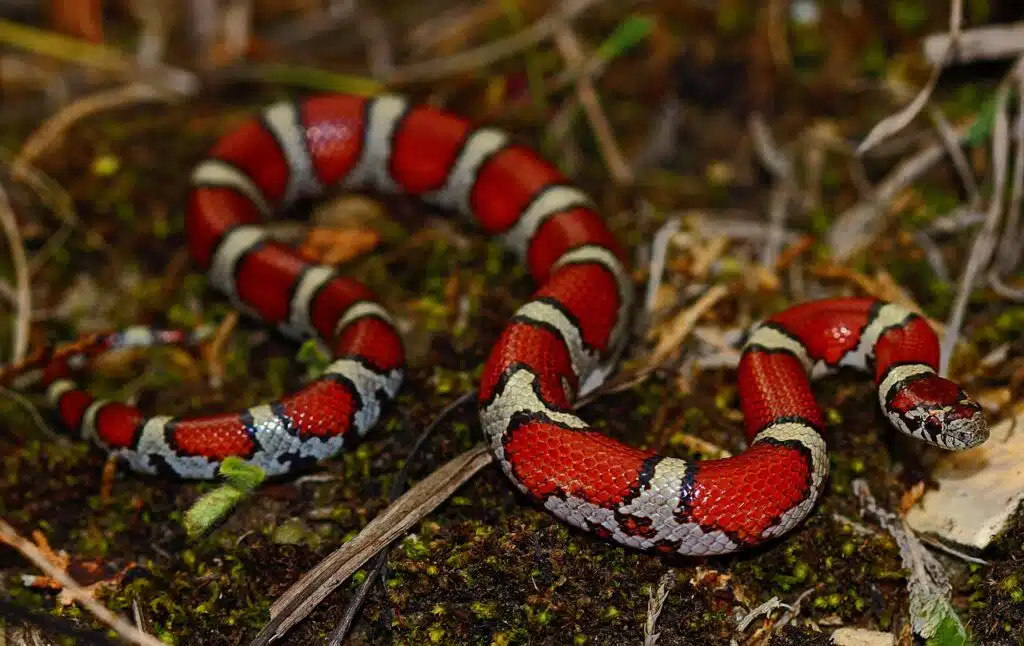
Unlike Graham’s Crayfish Snakes, Eastern Milksnakes (Lampropeltis triangulum) is a species commonly raised in captivity due to its multiple morphs.
Green, brown, red, and red-brown, the snake grows up to a size of 52 inches.
It inhabits crops, fields, woodlands, and suburban areas together with all territories rodents are found in.
Also referred to as The Spotted Adder, Eastern Milksnakes are docile and bites are rare.
This species is also referred to as the Cow Sucker Snake through the myth that it sucks milk straight from cows.
Stepping on the snake or roughly handling it might result in a bite.
26. Mississippi Green Watersnake
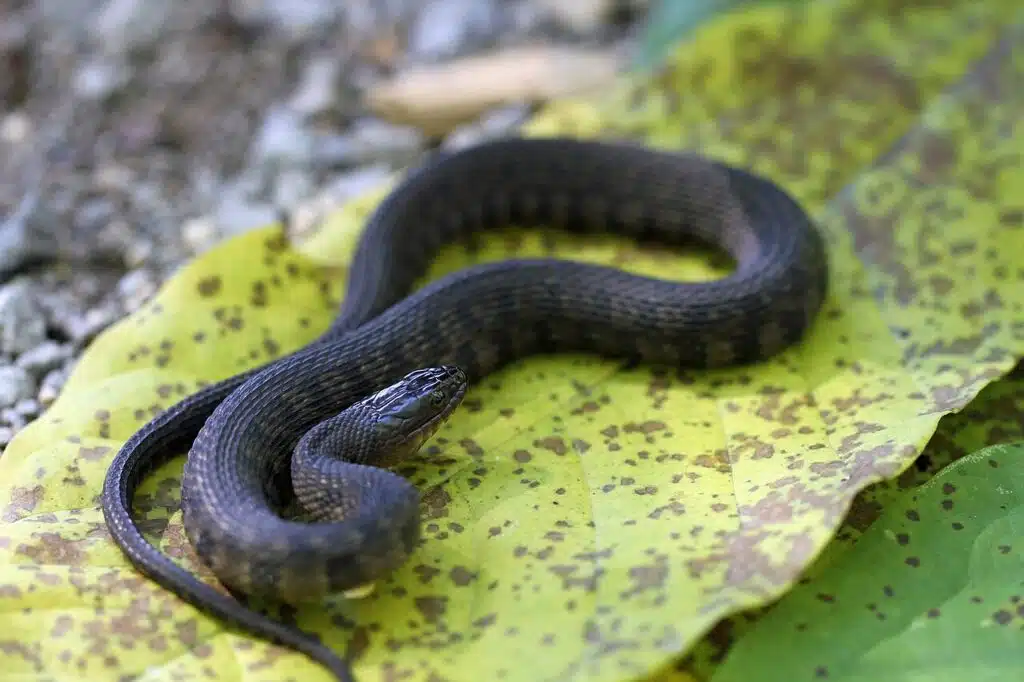
Some of the rare snakes of Arkansas are the amphibian-eating Mississippi Green Watersnakes (Nerodia cyclopion).
This aquatic species also eat various species of fish and tadpoles.
While a large species may grow to a size larger than 40 inches, Mississippi Green Watersnakes don’t overpower fish by constriction but they swallow them alive.
A fairly docile species, the Mississippi Green Watersnake bites rarely.
These snakes prefer to release a musk-like smell first.
One of the best methods to avoid these snakes is to stay away from swamps and dense vegetation around ponds and lakes.
Late summer marks the time of the year females are seen giving birth to a group of up to 34 live juveniles.
27. Scarletsnake
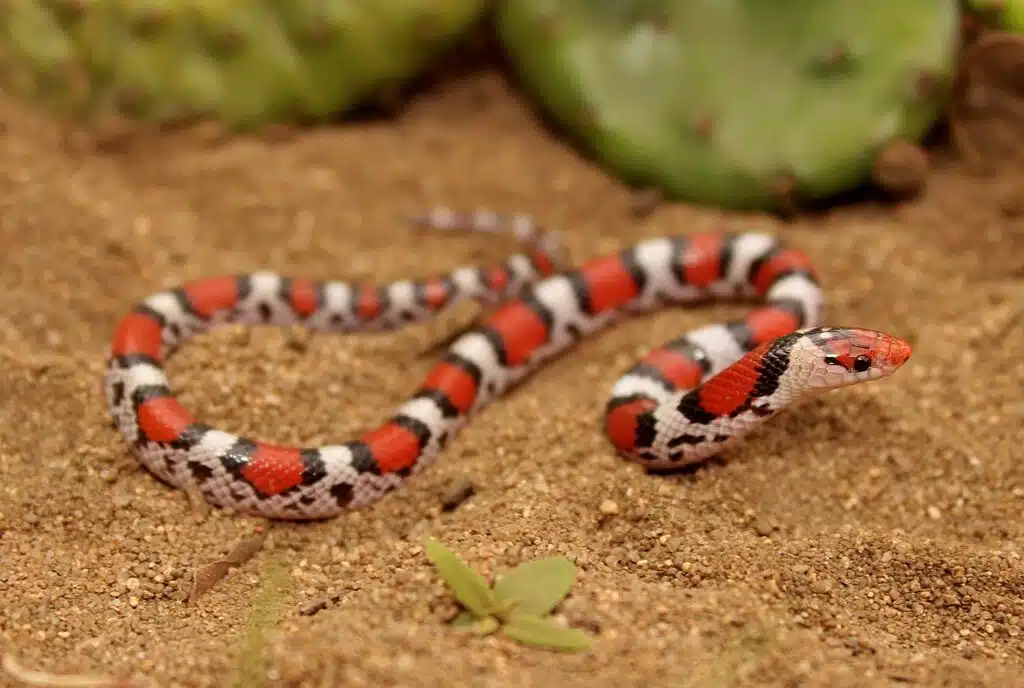
A red species with black and white crossbands, Scarletsnakes (Cemophora coccinea) are a small to medium species.
This snake grows up to a size of 26 inches.
A docile species, Scarletsnakes prefer to flee and bites are rare.
This is a species adapted to a diverse diet which includes eggs and even the eggs of other snake species. Large teeth at the back of its mouth are used on eggs.
Scarletsnake populations across the state are believed to be diminishing.
Its colorful nature makes it an attractive species for the snake pet industry while road killings are also common.
Scarletsnakes are found in open sandy soils or soil with leaf litter so that they can make a quick escape when necessary.
28. Great Plains Ground Snake
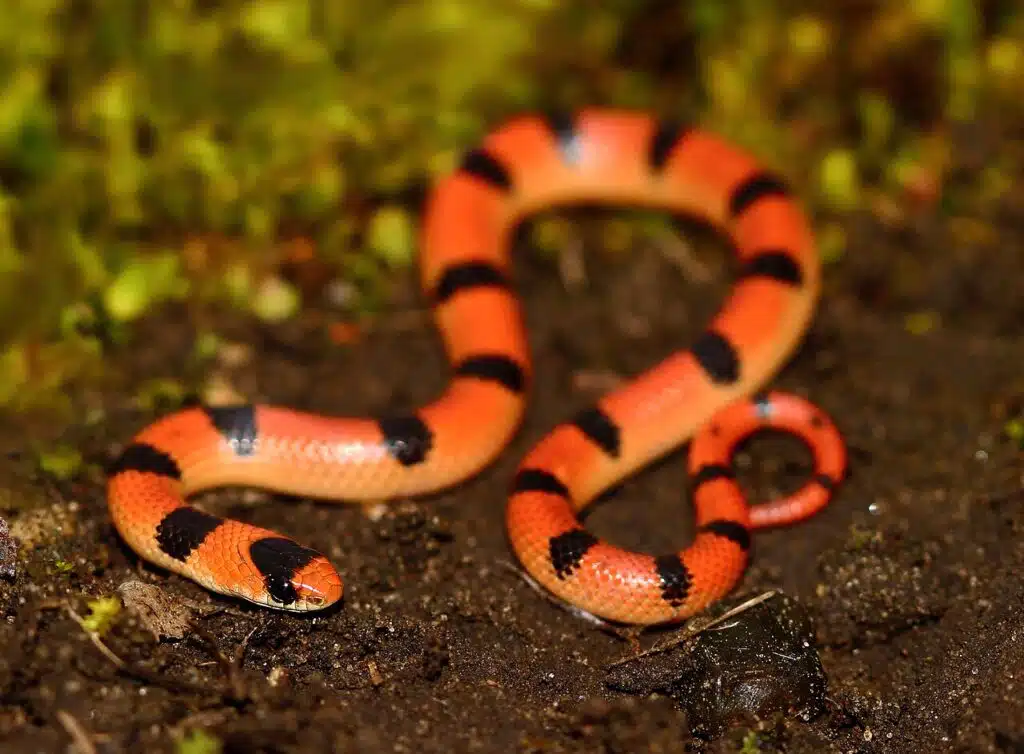
A secretive species that likes loose soil, the Great Plains Ground Snake (Sonora episcopa) is one of the species that comes in multiple colors and different patterns.
Orange, red, and brown colors are seen in the species. These colors may be backed by crossbands or they can be uniform.
Great Plains Ground Snakes that don’t have plain colors are seen with black banding.
The species is one of the smallest in the state, growing to a maximum size of just 19 inches.
Many Great Plains Ground Snakes are even smaller, measuring around 10 inches.
A nocturnal species, the non-venomous snake has a diet based on soft scorpions, centipedes, and various types of bugs.
29. Queensnake
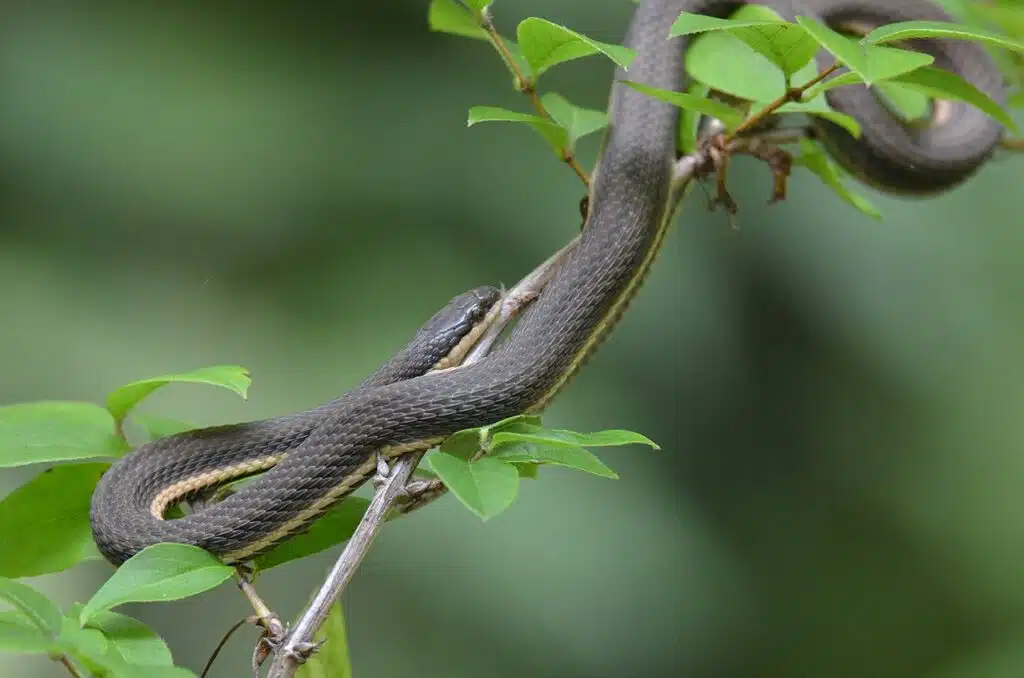
A native species, Queesnakes (Regina septemvittata) are seen in dark olive green colors dorsally and bright ventral color with dark olive green stripes.
The species still have stable numbers across the state but it faces decreasing numbers in the Northern US limits of its range mainly due to water pollution.
Growing up to a size of 24 inches, Queensankes live in or next to water.
Crayfish make up the bulk of their diet. Queensnakes prefer young crayfish but may also eat fish and frogs.
The species is also known to favor some of the cleanest waters. It prefers streams and rivers with rocks on the bottom as opposed to the ones with sandy bottoms.
The water temperature should also be warm enough for the snake to consider swimming for food.
30. Glossy Swampsnake
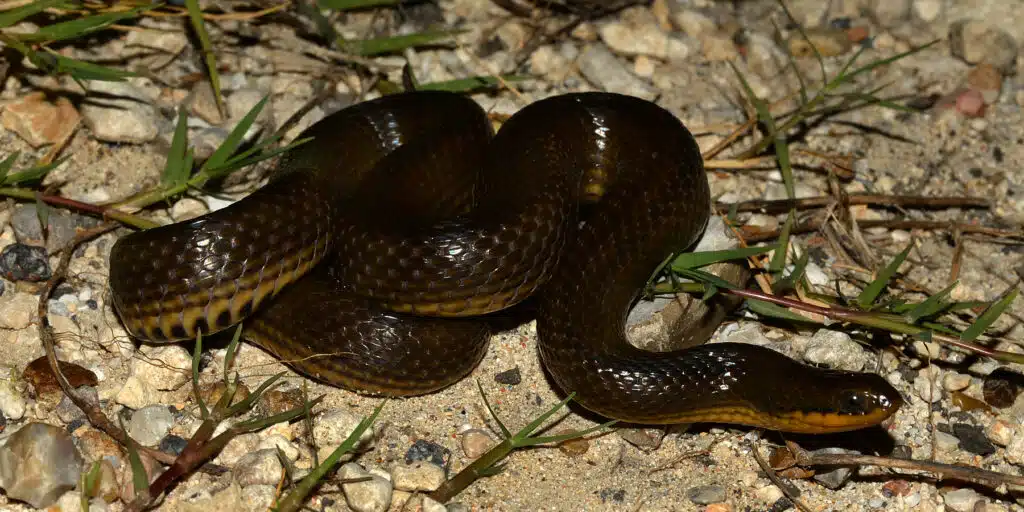
Glossy Swampsnakes (Liodytes rigida) are found in Arkansas and other Southeastern US regions.
This is a snake that has brown or green coloring with a yellow underbelly that also features dark stripes.
An aquatic species, Glossy Swampsnakes feed on crayfish.
This is a small species that may reach a length of up to 16 inches.
Some of the largest Glossy Swampsnakes hold a record length of 31 inches.
Glossy Swampsnakes aren’t venomous. These snakes can be handled and they tend to coil their body around the hands.
31. Eastern Worm Snake
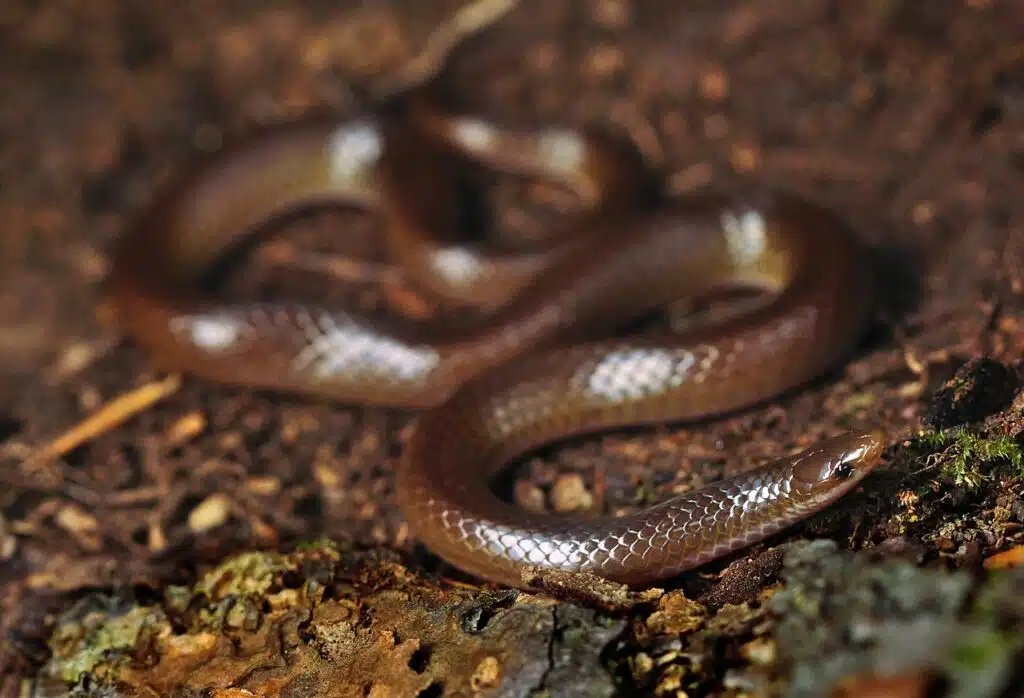
Eastern Worm Snakes (Carphophis amoenus) are an elusive species found in grasslands and grasslands next to woodlands.
This species is one of the multiple fossorial snakes in Arkansas. It has a brown color or a black color with red ventral coloring.
Eastern Worm Snakes are also some of the smallest species in the state.
This snake rarely measures more than 10 inches with only the largest individuals reaching a size of 13 inches.
Snakes of this genus are known for living in high densities in the ground.
It feeds opportunistically with prey it can find in the ground. Slugs and bugs are among the only foods it can find.
32. Lined Snake
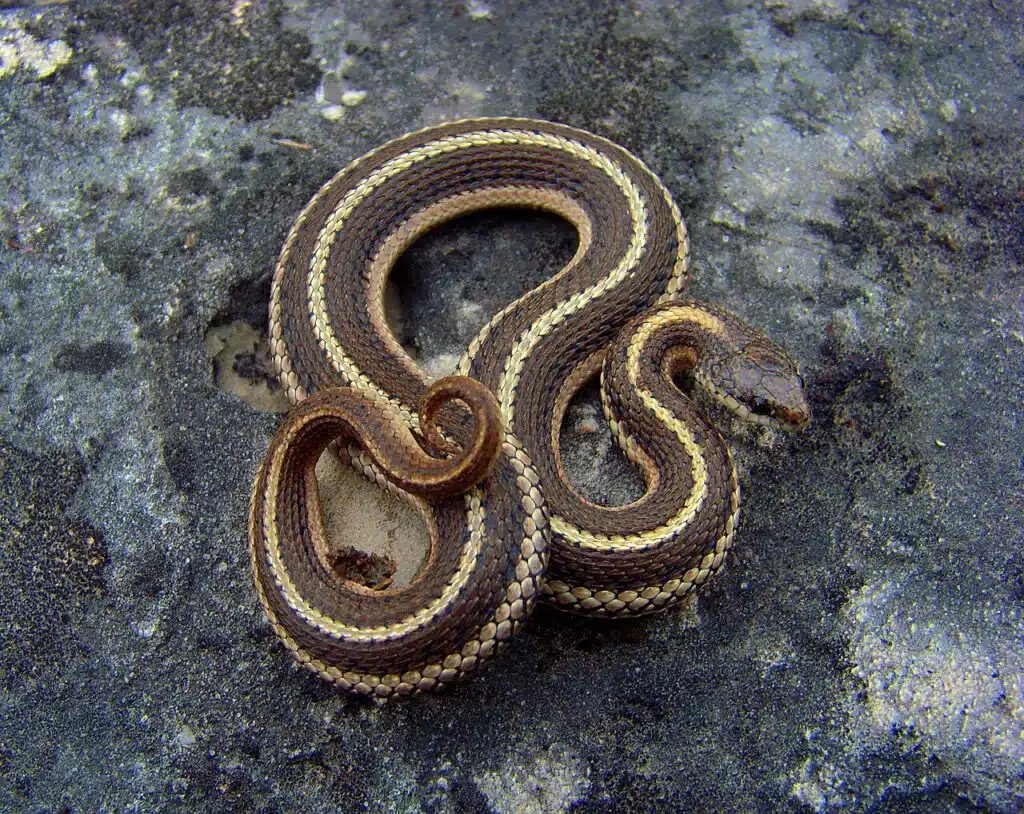
The Lined Snake (Tropidoclonion lineatum) is one of the semi-fossorial species in Arkansas. This is a snake that can spend time both underground and in leaf litter.
A secretive nature is specific to the species that spends much of its time hiding.
Named after the stripes on its body, this is a species that solely feeds on earthworms.
A non-venomous species, Lined Snakes have short thick bodies.
This species may reach sizes of just over 20 inches.
They are distinguished by a gray, brown, or green body with yellow or black stripes.
33. Gopher Snake
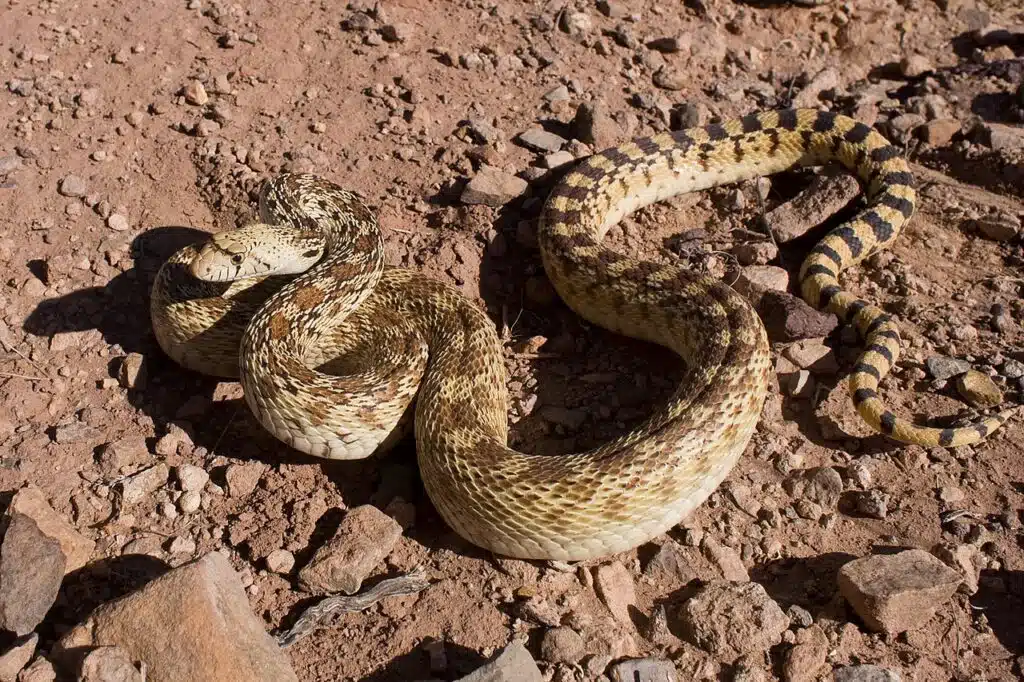
Some of the longest-living species in Arkansas are Gopher Snakes (Pituophis catenifer).
This snake can survive up to 15 years in the wild and even more in captivity.
Different colors are specific to Gopher Snakes. This species has gray or light brown coloring with dark brown blotches.
It can be found in different habitats across crops, parks, woodlands, and gardens.
Gophers Snakes are both diurnal and nocturnal. As opportunistic feeders, these snakes constantly move around for prey.
Unlike other species, non-venomous Gopher Snakes don’t bite directly.
These snakes hiss and flatten their heads whenever cornered or threatened.
34. Western Ground Snake
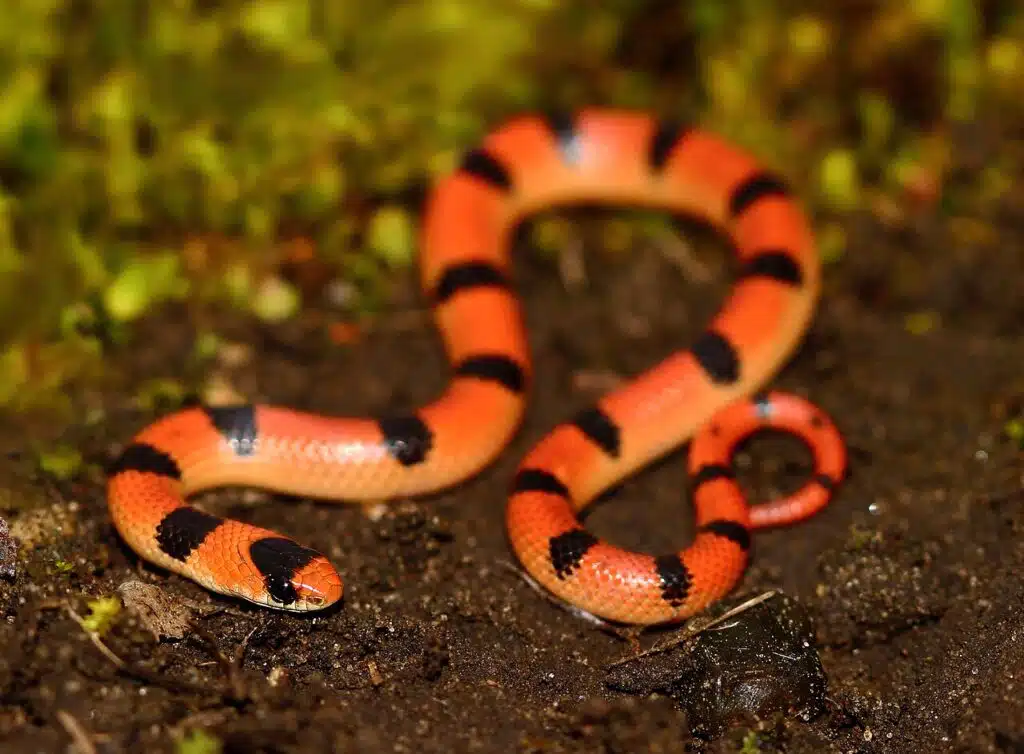
Orange and red colors with black bands are specific to the Western Ground Snake (Sonora semiannulata).
A slender snake with smooth scales, Western Ground Snakes live in the ground, in loose soil, under rocks and logs, as well as in leaf litter.
Snakes of this family feed on small arthropods. Centipedes are among the preferred prey of the species.
Summertime marks the period this species is most active as females may be spotted looking for places to lay eggs.
35. Gray Ratsnake
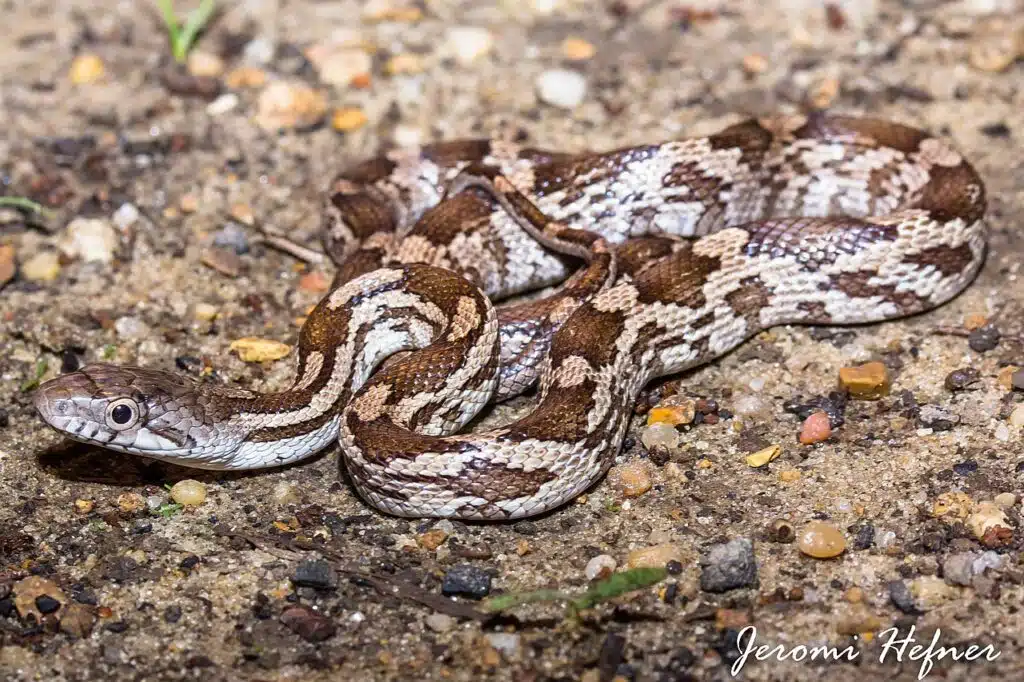
Mostly black, Gray Ratsnakes (Pantherophis spiloides) are among the species sometimes spotted in habitats with rats.
These habitats include crops, farms, barns, and garages.
Gray Ratsnakes measure at least 3 feet and they can reach a size of up to 6 feet. They rely on their large bodies for prey constriction.
Female Gray Ratsnakes may be spotted around woodlands in the summer when they lay groups of at least 5 eggs after mating.
36. Pine Snake
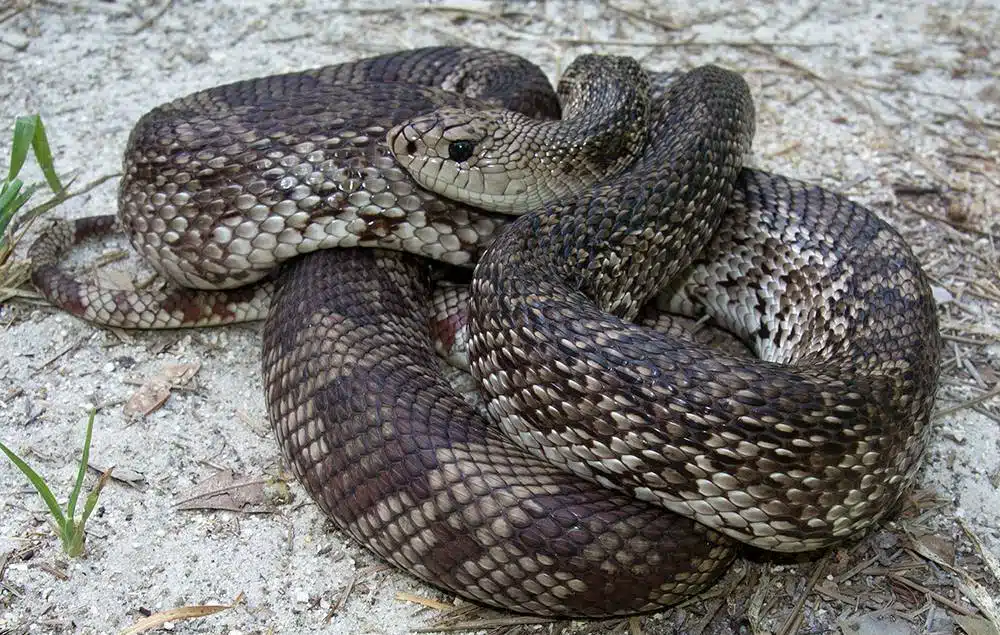
Flatwoods, loose soils, and easily-drained soils are ideal habitats for Pine Snakes (Pituophis melanoleucus).
Also known as a Bullsnake, this species is one of the rare large snakes in the state.
It can reach a maximum size of up to 90 inches.
The large size of Pine Snakes allows the species to eat prey such as foxes.
A light gray color with black blotches is specific to this species which also comes in a morph with red-brown patterns.